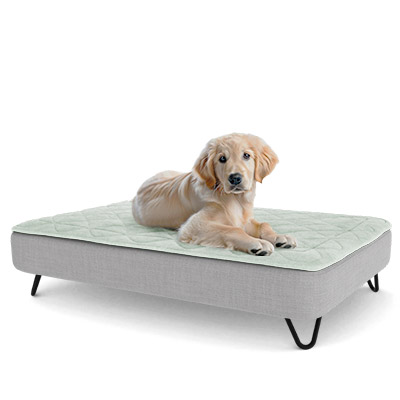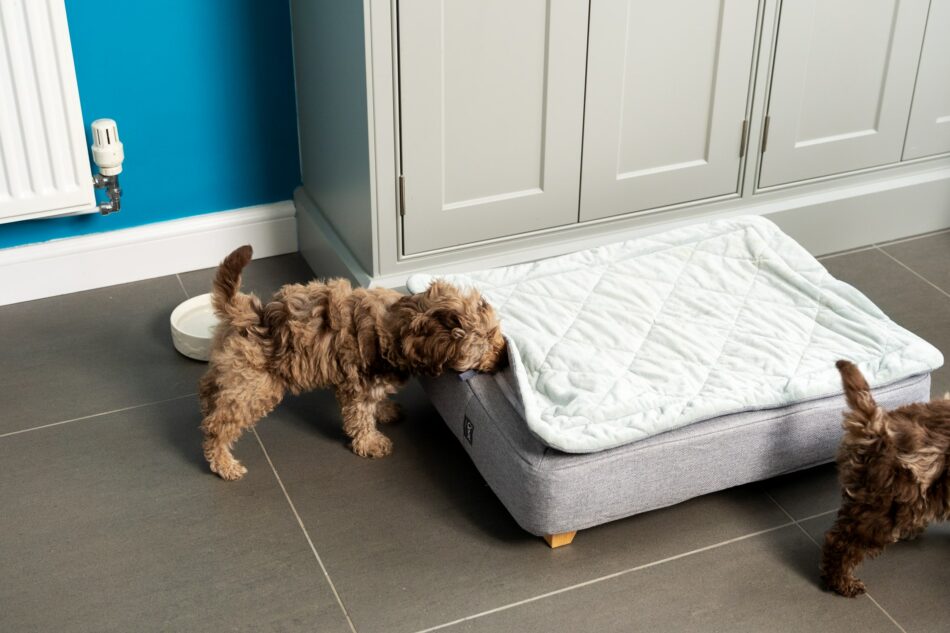
Ahh, the eternal question: how long should a dog bed last? It’s a topic that’s stumped pet owners for ages. As humans, we typically change out our mattresses every 6-8 years depending on brand and usage. But with dog beds, there are a lot more factors to consider. Should a dog bed last a year? Five years? Ten years? Or should it last until the end of time itself? At Omlet, we think dog beds should last forever! So let’s take a closer look at your dog’s bed and what you can do to keep their comfort going for life and keep their bed out of the landfill.
Why standard dog beds don’t last
Let’s be honest – dogs are known for many things, but being gentle with their belongings is usually not one of them. They love to chew, dig, and drool on anything they can get their paws on, including their dog beds. In addition, most dogs sleep on their beds for all naps and nighttime sleep, incurring lots of usage and extra smells. It’s fair to say that dogs use their beds more than humans use their mattresses.
As a result, standard dog beds simply can’t withstand the normal wear and tear of any dog breed. Most standard dog beds are constructed of non-durable and non-washable materials, making them unable to provide quality comfort for your dog for very long. So if you’re expecting a standard dog bed to last forever, you’re barking up the wrong tree. But rest assured – there are other dog bed options from Omlet available that will keep your canine comfortable for life.
How long should a dog bed last?
On average, most standard dog beds last anywhere from 6-12 months. If it’s not the rips and tears from your dog’s natural behaviors that prematurely send it to the landfill, then the build-up of odors and hair will. At Omlet, we believe that dog owners should be able to buy one dog bed that will last their furry friend from puppyhood to prime.
Our product designers set out to challenge the standard dog bed norm and create a dog bed that would not only provide the highest quality comfort to your dog, but would last their lifetime as well. Their solution – the Topology dog bed.
3 ways to know it’s time for a new dog bed
How do you know when it’s time to buy yourself a new mattress? More than likely, it’s when you start having consecutive nights of uncomfortable sleep or can see defined lumps and dips throughout. But how do you know when it’s time for your dog to have a new bed? Here are 3 ways you can determine if your dog needs new digs:
The two most common dog bed fillers are stuffing and memory foam. So in order for any standard dog bed to stay supportive of your dog’s joints and comfort, the interior filling needs to be uniformly thick across. But how can you tell? By performing a quick thud test. Simply take your flat hand and hover it a few feet above your dog’s bed. With a swift motion, drop your hand onto the dog bed to mimic your dog plopping onto their bed. If you hear a ‘thud’ when it hits, then it means the supportive filling has gone flat and it’s time for a new dog bed.
No really, we mean it – smell your dog’s bed. And we don’t mean from the other room. We mean get down on the ground and give your dog’s bed a good whiff. Any bacteria or other microbes that may have started to build up inside your dog’s bed may only be fragrant up close. But guess what? That means this smell is transferring to your dog every time they snuggle up for a snooze. So if you sniff a bad whiff it’s time for a new dog bed.
Give a complete inspection
At first glance, most standard dog beds may appear to be in perfectly good shape. But give it a closer look and you may see something else. In order to really know if your dog needs a new bed, you need to give it a thorough inspection. If the cover is removable, take it off to look at the insert. Mold and mildew can hide in seams and crevices from excess drool, making your dog’s bed worse for wear. And if the inside of your dog’s bed looks that bad, imagine how uncomfortable it must be.
Omlet’s Topology dog bed
As the pet company that does things differently, we set out on a quest to create a comfort solution that would be your dog’s sleeping companion for life. We’re pet owners, too, and like you, we’re tired of worn-out, uncomfortable dog beds filling up our landfills. So we decided to do something about it. We decided to engineer the last dog bed you’ll ever need to buy.
The Topology dog bed, designed by Omlet, is a completely customizable dog bed that will literally transform your dog’s sleep. The luxurious memory foam mattress is completely encased in a water-resistant cover to give your dog high-performance sleep without the worry of bacteria build-up. And with Topology, you can also customize your dog’s comfort with one of the multiple different topper options so you can give your dog the exact sleep they want.
The best part? Every single topper is easy to remove and completely machine washable. Simply pop a new topper on the bed while the other is in the wash, or if a topper gets worn out, simply replace it with a new one without having to buy a new bed.
In fact, we know this bed is so durable and high-quality that we guarantee it can withstand the harshest of critics – puppies. Yep, that’s right. With the Omlet 180 Day Puppy Guarantee, we back the Topology dog bed and Quilted topper, AKA the Omlet Topology Puppy Bed to withstand the shark-like chewing of every dog bed’s worst nightmare. If within 180 days your puppy chews through the Quilted topper of the Topology bed, we’ll replace it for free. How’s that for the last dog bed you’ll ever buy?
Omlet and your dog
At Omlet, we don’t just assume we know what your dog needs in a dog bed. We use our personal experience and unparalleled understanding of the best products available to engineer dog beds that deliver quality, comfort and ease of care so your dog not only gets what they need, but also what they want. After all, our dogs deserve the best, right? With the Topology dog bed, your dog will be laying in the lap of luxury from puppyhood to prime and giving you many tail wags of thanks in return. Let us do the work, so you can reap the rewards.
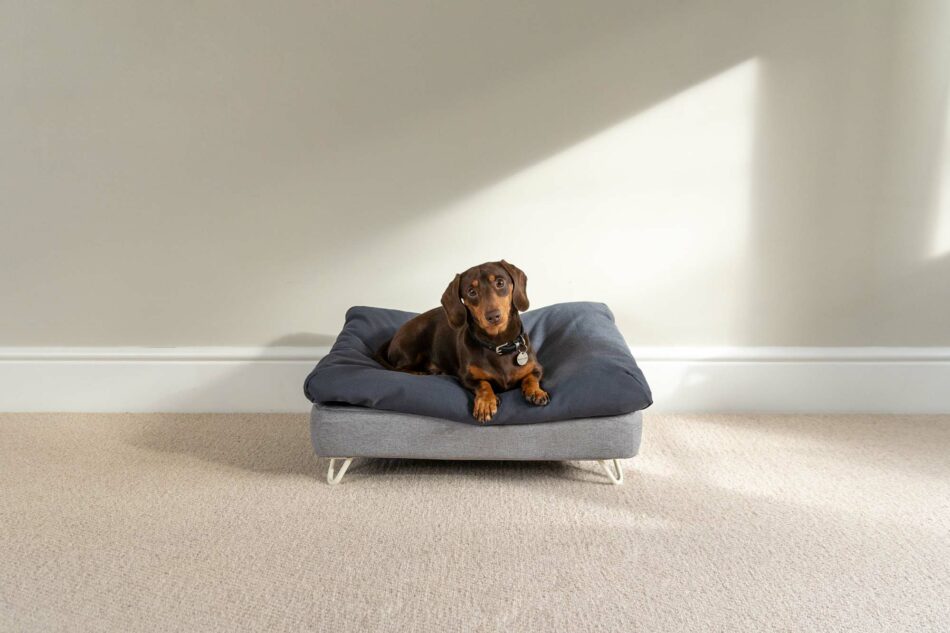

This entry was posted in Dogs
Golden retriever puppies are undeniably adorable with their fluffy coats and playful personalities. But there’s one thing that can drive their pet parents crazy: their propensity to chew on everything in sight. From shoes to furniture, these pups seem to have an insatiable desire to gnaw on anything they can sink their teeth into. But why do golden retriever puppies chew so much? And, is there anything you can do to stop them?
Let’s get to know the goldens
Sweet, loyal, lively and incredibly good with kids – it’s no wonder golden retrievers are one of the most popular dog breeds in the U.S. But what makes this breed so, well, golden? Let’s go back to the 19th century when they were first bred to find out.
In 1868, Lord Tweedmouth of the Scottish estate of Guisachan was interested in sporting and hunting dogs and finding one that could handle the Scottish climate and terrain. After failing to find any existing breeds that could keep up, he decided to create his own. By breeding a flat-coated retriever with a tweed water spaniel, Lord Tweedmouth helped create what we now know as the beloved golden retriever.
As seen in their medium to large size stature and solid, athletic build, the golden retriever has the sporting and retrieving genes all through their DNA. Coupled with their high canine intellect and effortless ability to learn commands, it’s easy to see why the golden retriever has long since been known as the preferred dog for hunting.
But even though the sport has been domesticated out of the golden, the instinct to catch and carry is still strong in this breed. Hence the reason these dogs, especially as puppies, like to put everything in their mouths.
Do all puppies chew?
Puppies use their mouths to explore the world around them, so it’s fair to say that there’s a method behind the madness (and destruction) of this natural behavior. Here are some of the reasons puppies chew.
- Stress relief: Puppies, in particular, use their mouths to help them cope with stress. And when they come home with you, dog separation anxiety can continue when they see you leave the house or even just the room. Chewing helps to soothe their anxiety and provides a source of comfort.
- Pain relief: Chewing is also an essential part of a puppy’s teething process. As puppies grow, their baby teeth fall out, and their adult teeth grow in. This can be a painful process, and chewing helps alleviate discomfort by massaging the gums and providing an outlet for the growing teeth. It’s not uncommon for puppies to chew more during this time to seek pain relief.
- Exercise relief: All puppies require plenty of exercise and stimulation to keep them happy and healthy. When they don’t get enough run and play time, puppies can become bored and restless, and chewing becomes a way to alleviate that boredom. Providing plenty of dog toys, exercise, and attention can go a long way in curbing unwanted chewing behavior.
- Communication relief: Dogs don’t speak human. So in order for them to tell us something, they have to find a different way to communicate. Puppies use chewing as a way to signal to their owners that they need help, are frustrated, or just want some attention. By observing your puppy’s body language and chewing habits, you can better understand what they are trying to communicate so you can respond accordingly.
Thankfully, chewing is predominantly a puppyhood behavior and should subside considerably with age. If you notice that your older puppy or teenage dog is still chewing things around the house once they are out of this stage, it may be time to visit your veterinarian to make sure there are no underlying causes.
How do you stop a golden retriever puppy from chewing?
The short answer is you don’t. Chewing is a natural part of puppyhood, no matter the dog breed. But, there are ways you can redirect this destructive habit so your puppy can find healthier outlets for their instinctual behavior.
Not all chewing is created equal
While it’s natural for golden retriever puppies to chew, it’s important to make sure they are chewing on appropriate items. You don’t want your new shoes, your favorite piece of furniture or even worse, their own dog bed to become your puppy’s new chew toy.
One of the best things you can do is provide your puppy with plenty of appropriate chew toy options. Look for toys that are specifically designed for puppies, as these will be softer and gentler on their developing teeth. You may also want to try a variety of textures and shapes to see what your puppy prefers. The more they chew their toys, the safer your furniture will be.
Smart dogs need stimulating
Golden retriever puppies are clever dogs, and they need plenty of opportunities to learn and explore. So one of the best ways you can try and curb your golden’s chewing habits is by increasing their exercise habits.
Keeping in mind that puppies are still not able to manage hour-long walks at these young ages, you can still keep them active during wake times with short walks around the block, energetic games of fetch or even just a stroll around the backyard to get lots of sniffs for mental stimulation. When it comes to puppies and chewing, it’s good to remember that a tired puppy is a happy puppy. And tired puppies are more likely to sleep in their bed than chew it.
Puppy patience
It’s essential to remember that golden retriever puppies are still learning and exploring the world around them. They’re not intentionally destructive or trying to be difficult. Instead, they’re simply trying to understand their surroundings and find their place in the world. By providing plenty of love, patience, and training, you can help your golden retriever puppy learn appropriate chewing behavior and become a happy, healthy, and well-behaved member of your family.
The best bed for a golden retriever puppy
When it comes to choosing the perfect dog bed for your perfect golden retriever puppy there are a few important factors to consider. First and foremost is the size. Puppies grow…fast. So you want to get a dog bed that’s large enough to accommodate their growing body and give them the comfort to stretch out at any age.
But even more important than size is the durability of the dog bed. Did we mention that golden retriever puppies like to chew? The best dog bed for a golden puppy is one that is made from high-quality materials that are not only able to withstand constant chewing, but easy to keep mess and muck free.
The Topology Puppy Bed, designed by Omlet, is a first-in-class dog bed that can comfortably meet all your golden retriever puppy’s needs. Not only is this durable and high-performance dog bed comfortable and machine washable. It’s also claw and tooth-proof. If within the first 180 days, your puppy chews through their Quilted Topper, we’ll send you a replacement, as part of our 180 Day Puppy Guarantee.
Omlet and your golden retriever puppy
At Omlet, we believe puppyhood is one of the best hoods to be in. Yes, it comes with its share of frustrations and destruction, but the love and happiness you get in return is unmatched. As the ideators and new benchmark makers of the pet products industry, we’ve taken our expertise to the next level and designed dog toys, dog beds and every other dog product you need to keep your golden retriever and you happy together – and your furniture intact.

This entry was posted in Dogs
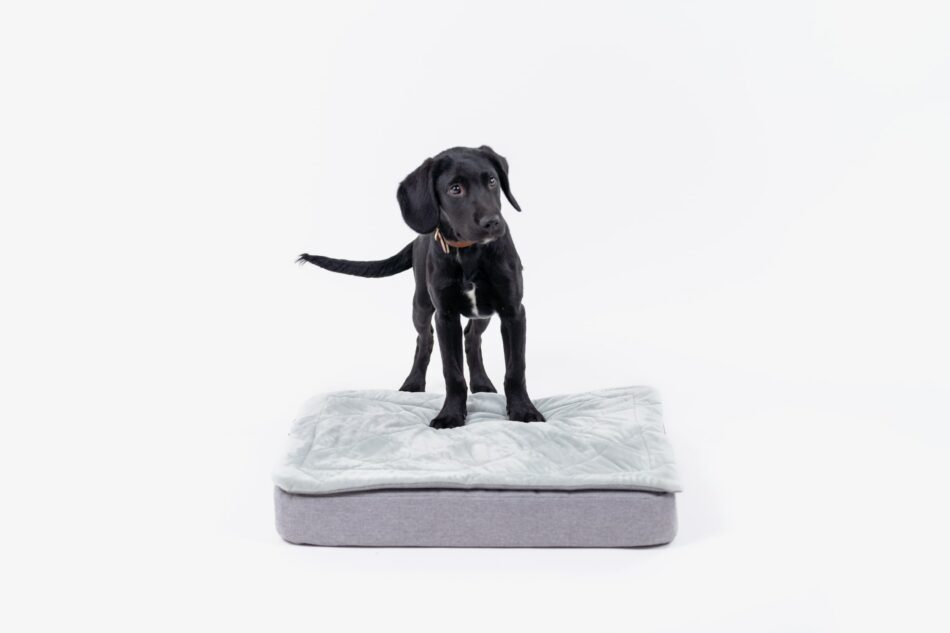
Choosing the right dog bed for your puppy can be tricky – or at least it used to be…Omlet’s Topology dog beds tick all boxes for your new best friend’s nap time needs, meaning you no longer need to compromise on what your puppy truly wants. Say goodbye to flimsy mattresses, chewed-up toppers and bad bed odors and discover why Topology is the perfect solution.
Comes in three different sizes
Depending on your dog’s breed, your puppy might be super small at the moment, but they’ll quickly grow up to be a full-sized dog before you know it. And since the Topology dog bed is the last you’ll buy, we recommend buying a bed based on their predicted measurements as a fully-grown adult dog. You want to make sure that your dog will be able to fit on the bed in all possible sleeping positions. The bed might look comfy when they’re curled up into a furry little ball, but would they be able to stretch out their legs if they wanted to? As they grow older you’ll find which positions they tend to sleep in, but for now, it’s best to go slightly bigger to be on the safe side.
The Topology dog beds come in three sizes to accommodate all breeds and are designed to fit snugly into standard-sized crates, avoiding any gaps along the sides. Just be sure that if you’re planning on dog crate training and want to put your bed in the crate, check your dog’s crate dimensions to ensure it fits. Take a look at our dog size guide so that you can match your breed to the right bed.
Choose from a range of removable toppers
The genius of the Topology design means that you can choose a range of versatile dog bed toppers which can all easily be removed to put in the wash, reducing odors and improving home hygiene.
For puppies, we recommend the Quilted topper, designed by Omlet with razor-sharp puppy teeth in mind. This super soft topper means optimum comfort for dogs of all ages and the durable fabric with the option to zip a puppy pad underneath, makes this style perfect for growing dogs. We’ll even replace your Quilted topper or mattress cover for free should your puppy chew through it within the first 6 months under our 180 Day Puppy Guarantee*.
Whilst your Quilted topper is being washed clean, you can choose an extra topper to zip onto your Topology dog bed. The Sheepskin topper is ideal for smaller puppies that might need a bit of extra warmth, transforming their bed into a cloud of tranquillity. Plus, you can pick from five different colors of this luxurious topper to match your home decor.
Minimise chewing damage
All puppies will chew – there’s no way around it. Dog breeds such as Golden Retrievers that are bred to use their mouths to fetch and carry are more likely to destroy anything that comes in their way, as well as breeds with a high prey drive.
You can of course train your puppy from an early age to only chew appropriate dog toys or other accessories, but if they do manage to get those sharp teeth into their bed, the design of the Topology Puppy Bed means they’ll likely be unsuccessful in getting through the topper or mattress.
No need to worry about dirt and accidents
Puppies get into all sorts of mess, so being able to zip off the topper and put it in the washing machine will make your life a lot easier, and your dog will appreciate having a fresh bed to return to.
This goes for puppy toilet accidents as well. If there’s a leak, the mattress under the topper has a waterproof cover that you can easily remove and wash with the topper. If this becomes a recurring problem, you can even put a puppy training pad on the mattress before your zip on the topper to soak up any accidents.
Provide premium comfort
Puppies sleep up to 20 hours a day, and it’s super important to give their growing bodies extreme comfort and support. Keeping your dog off the ground on a sufficiently padded surface can prevent severe arthritic pain in the future, so make sure you choose a good-quality bed.
Topology dog beds have a memory foam mattress that moulds around the body as the dog lays down on it, and provides amazing support for tired legs after vigorous play. The toppers all add extra comfort, either by super softness against the body, like the Quilted or the Sheepskin, or by extra padding like in the Beanbag or Bolster toppers.
Pick the perfect extras
If you decide not to place your puppy’s bed in a crate, you can elevate your Topology off the ground with a range of stylish feet. Raising your dog’s mattress reduces drafts and improves the airflow under the bed, which helps minimise a build-up of mold, mildew, dust and debris.
It’s also a good idea to add a blanket to the bed to make your puppy’s Topology dog bed for an even better night’s sleep. Simply place your Omlet Luxury Faux Sheepskin dog blanket on your puppy’s bed and they’ll soon learn to associate it with a safe and calm environment. This means that if you go away on holiday or have to take your puppy to the vet for their jabs, you can bring the blanket and give him or her an extra sense of safety.
Omlet and your puppy
We’re confident that your new puppy will love their Topology Dog Bed, and you can be confident knowing you’ll have a dog bed to last a lifetime with our 180 Day Puppy Guarantee. Plus, with accessories such as designer dog bed feet and super snug dog blankets, your furry friend will be sure to have their own puppy paradise for years to come.
*Click here for full 180 Day Puppy Guarantee T&Cs.
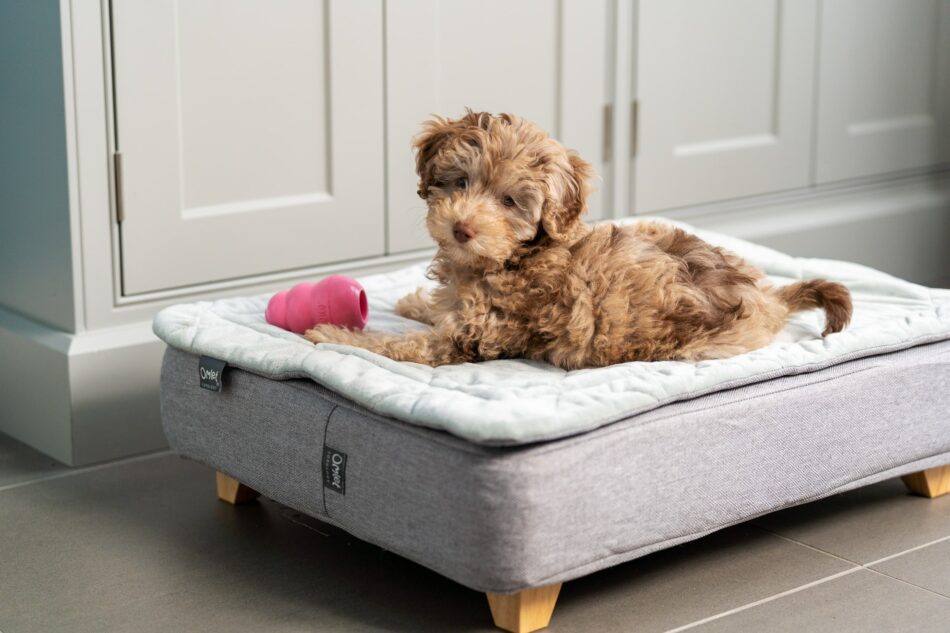
This entry was posted in Dogs
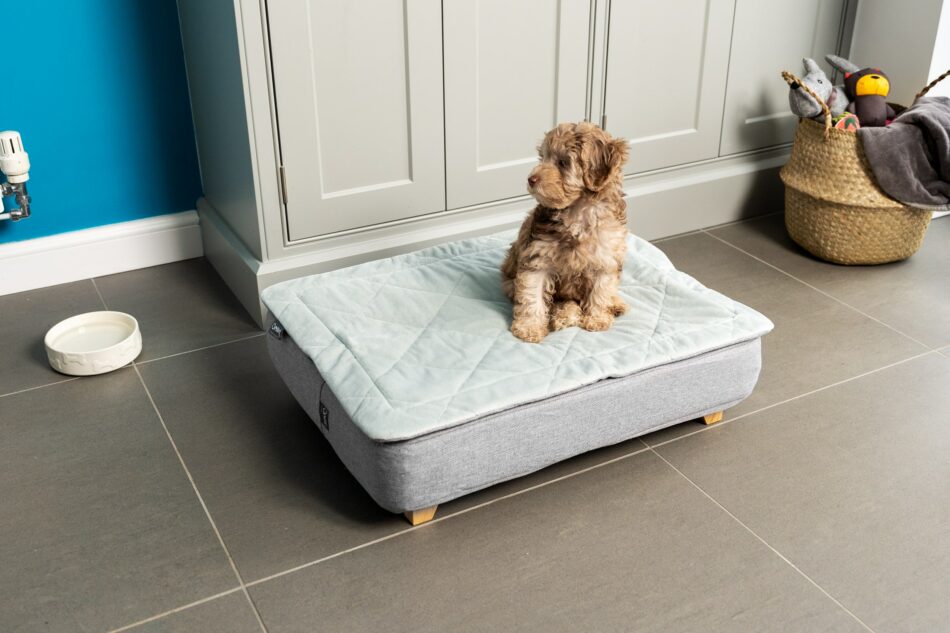
So you’ve added a new puppy to your family? Congratulations! Settling a new puppy into your life comes with all the highs of precious puppy snuggles as well as the lows of “Did they chew my shoes again?!” To help you make this transition easy, we’ve gathered everything you need to know on how best to settle in a new puppy. From simple steps to puppy products, Omlet has the advice you need to make the adjustment period smooth for everyone.
Puppy’s first 24 hours
Here’s the thing about adding a puppy to your family – it’s a lot of fun, but also a lot of work. Before you bring your new furry friend home for the first time, you need to make sure your home is prepped and puppy-proofed and that you have stocked up on all the new puppy essential products.
The first 24 hours at home can be an unsettling time for both of you. Everything is new to your puppy – your furniture, the space and even the smells are all foreign to your new bundle of joy. So it’s normal to expect lots of sniffing, pouncing and even some potty accidents. Likewise, you may feel a bit unsettled having a new living, breathing bouncing playmate running around. Especially if you have never owned a puppy or dog before.
While the first day together may feel uneasy or unfamiliar, fear not – it’s temporary and you both will start feeling settled in, in no time. Here are a few steps you can take in the first few weeks to make the homecoming less stressful and more enjoyable.
Introduce your puppy to their bed
Just like you have your personal bedroom where you sleep every night, you want to make sure you designate a spot in your home that is specific to your puppy as well. Having a familiar place to go to will allow your puppy to feel more comfortable and secure as they’re settling in.
The easiest way to create the perfect puppy place is with a dog bed. Not only will this be their spot for rest, but it will soon become their safe haven from any disturbances or distractions that might make them feel uncomfortable.
The Topology Customizable Dog Bed designed by Omlet is the perfect bed for a new puppy as it will not only grow with your puppy into adulthood, but you can customize it to their needs along the way. Engineered with a solid base and superior memory foam mattress, the Topology offers a wide selection of toppers that are easily zipped on and off the bed. This not only allows you to pick a personalized topper from a variety of fabrics and colors, but it makes cleaning the dog bed as easy as one, two, zip.
Each topper is made from durable, hard-wearing materials so even the toughest of new puppy teeth can’t chew through them. Our recommendation for puppies is the Quilted Topper as the soft, plush feel will give them unbeatable comfort while also maintaining the strength to resist a hard teething session – and it’s covered by our 180 Day Puppy Guarantee.
Keep visitors to a minimum
When you bring your new puppy home, it’s tough not to invite your mom, cousin, neighbor and even your local grocer all over to see your adorably cute new furry friend. But try to resist too many visitors over the first few weeks.
While socializing your new puppy is important, having too many visitors at once can actually become overwhelming and cause stress. So when it comes to meeting new friends, slow and steady is the best rule of thumb.
And when you do welcome visitors into your home, be sure your puppy has a safe place they can retreat to in order to feel secure, such as their dog bed or even a dog crate. Nothing makes a puppy feel more settled than the comfort of their own space.
Show your puppy where to go potty
Potty training your puppy is easy with these two simple steps: start early and be consistent. Whether you use puppy pads or the great outdoors, establishing a potty routine early on will make the process much easier on you both.
Keep in mind that your puppy is learning so much at this young age, so patience is key in potty training. Accidents will happen along the way, but with a regular schedule that starts the day they come home, your puppy will be potty trained in no time.
Let your puppy take it at their own pace
Having a puppy is kind of like having a toddler. Simple moments of playtime are filled with endless hours of excitement and it’s hard not to want to engage and play all day. But just like a toddler, all that play can make a puppy tired and knowing when to give them space is super important.
So make sure every family member is on the same page and knows how to give proper boundaries to the new addition. While it’s exciting to play with a new puppy, not all puppies want to play all the time. Every breed is different and your puppy will settle in at their own pace so long as you give them the space and time they need to do so.
Signs of a restless puppy
Imagine being transported to a completely new place you’ve never been to before and being surrounded by people and things you’ve never laid eyes on before. That’s exactly what it feels like for a new puppy when you first bring them home. All the new smells and sights can make a puppy feel restless but it’s important to make sure there are no underlying causes if the restlessness continues. Here are some signs of a restless, unsettled puppy:
Pacing
It is completely normal for your puppy to quickly traverse every room of your home during the first few days as that is how they learn about their surroundings. However, if you start to notice your puppy pacing back and forth in one particular area, this could be a sign that they are unsettled or even have some puppy separation anxiety.
When you notice this behavior, try to limit your time away from home to frequent short getaways as opposed to long periods, if possible. And when you do have to be away for hours at a time, make sure they have a comfortable dog bed and dog crate where they can feel secure and comfortable.
Regularly waking up at night
In the first few weeks, puppy sleep is very similar to baby sleep – it’s sporadic. And while you can expect to be up a few times each night for the routine potty breaks, you want to make sure that your puppy can settle back to sleep easily for more rest.
When you start to notice they are up for more of the night than they are asleep, this could be a sign they’re unsettled. In order to help your puppy get their much-needed sleep, get them a Topology Customizable Dog Bed so they can rest with comfort, support and ease.
Panting
Unlike humans, dogs don’t have sweat glands all over their bodies. So in order for them to cool down, they often pant as a way to try and cool themselves off but panting can also be another way you can tell if your puppy is unsettled.
If you notice your puppy panting, first check the temperature and make sure they are not just hot and need a doggy cool down. Sometimes a nap on a dog cooling mat is all that is needed to keep the panting to a minimum.
Puppy teething 101
If you’ve ever had your finger in the crossfire of puppy teeth you know all too well how sharp those tiny canines on your canine can be. Between three and eight months of age, puppies begin to have an uncontrollable urge to chew as a way to help relieve the discomfort of their gums.
And while teething is a completely normal part of puppyhood, it’s also one of the main reasons why your puppy may feel unsettled. For some puppies, the development of teeth is painful and confusing and the only comfort they can get is in biting and chewing on things. So in order to help your puppy through this unsettling process, make sure you have plenty of puppy-approved dog toys around so they can chew away on something other than your shoes and furniture.
Omlet and settling in your new puppy
There are few things in life as exciting and soul-filling as owning a puppy. Not only are you establishing a bond with your new best friend from the very beginning, but you get to experience all the wonders of puppy smells and snuggles along the way. At Omlet, we curate our products to care for and comfort your dog from puppyhood and beyond. With custom solutions like the Topology Puppy Bed, we strive to be your one-stop resource for all things pet related. We know what it takes to make your puppy grow into a healthy and happy adult dog. So we make the products you need so you can focus on your incredible relationship with your puppy.
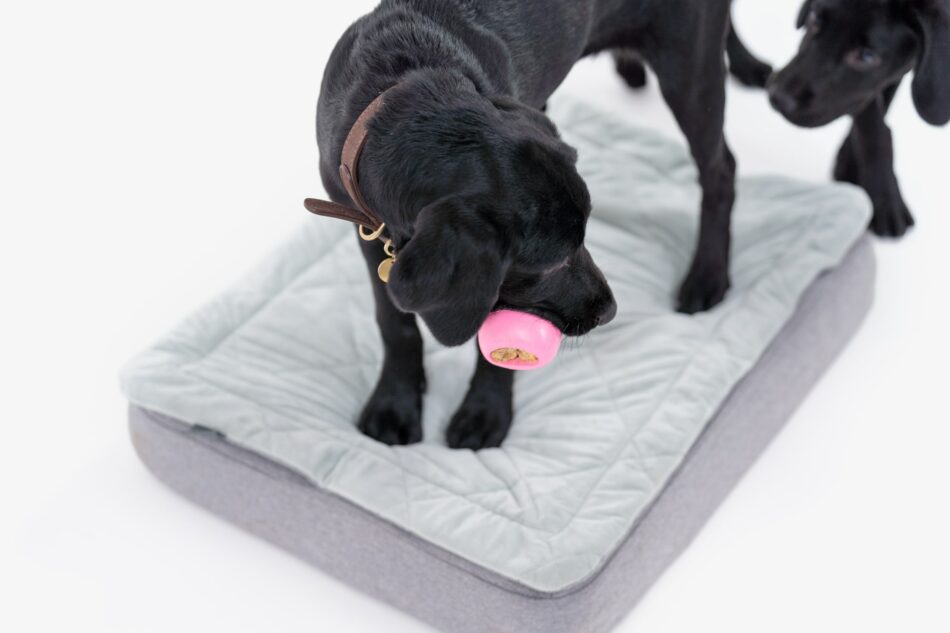
This entry was posted in Dogs
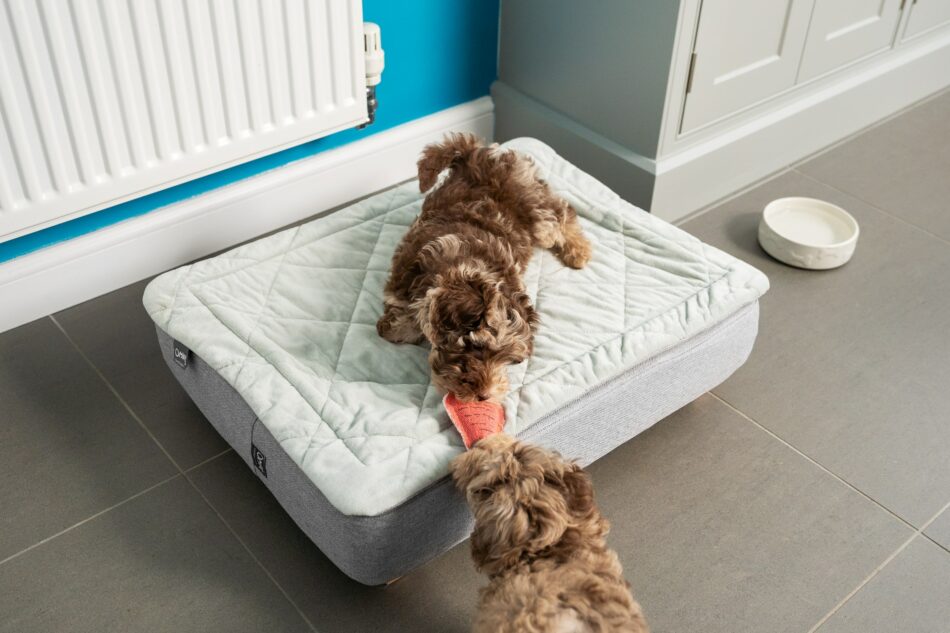
For puppies, the whole world is just one big chew toy. In order to explore their surroundings and everything in it, they use their mouths and teeth to chew through their curiosity. While this behavior is extremely normal and expected, that doesn’t take away the fact that it can also be frustrating and destructive – especially to your furniture, shoes or even their dog beds. So if you’re a puppy parent wondering when the bite marks and chewed socks will end, keep reading. Omlet has the advice and products you need to help redirect your puppy’s chewing.
Normal puppy chewing behavior
Just like babies, puppies experience pain and discomfort when teething. For the first 6 months of a puppy’s life, they spend much of their time chewing and biting as a way to help give their mouth and teeth some relief. It’s perfectly normal for puppies to chew as a way to strengthen their jaws, stimulate their brains and relieve anxiety – they literally can’t help it!
While some dogs can be mouthier than others, if you’re noticing your puppy chewing and biting excessively, there could be some underlying reasons to keep an eye out for. In the states, most puppies can be adopted by a human family as early as 8 weeks old. However, sometimes these precious pint-sized pups are separated from their mother much earlier than they should, causing them severe separation anxiety and a heightened tendency to suck on fabric. As a result, puppies in this instance could display more chewing habits for longer periods.
In addition, puppies who are bored or not receiving enough attention once they are in your home could exhibit more chewing as well. But regardless if your puppy is a mild, moderate or mega chewer, this behavior is only temporary and there are ways it can be redirected and eventually resolved.
Puppy-proof the house
The first golden rule of puppyhood that should be followed at all times is this – never leave your puppy unattended to roam free in your house. We promise it will lead to mass destruction! So the best thing you can do before you bring your puppy home is designate which room in the house will be the temporary puppy pad. We suggest a room with tile and not carpet.
The second golden rule of puppyhood is to remember to have patience. While the natural behavior of chewing and biting can be redirected, it is a slow process that will take time and inevitably have many ‘slip-ups’ along the way. So be prepared to deal with several chewed-up socks, shoes and even dog beds.
Fortunately, Omlet has solutions as we know puppy chewing is nothing to be messed with.
That’s why we created our Puppy Bed to be durable enough to withstand the power of puppy teeth. In fact, we’re so confident in the engineered resistance of the quilted topper that we have a 180-day puppy guarantee on this style. In the unlikely event your puppy chews through the quilted topper in less than 180 days from purchase, we will replace it for free*.
Tips to redirect puppy chewing
While we do know that your puppy won’t be able to chew through their Omlet Topology bed, we are certain that they will find something else to chew on. After all, puppies will be puppies. So here are some ways you can help redirect your puppy from chewing anything else in your home.
Did you know that puppies can get bored? Kind of hard to believe given their bubbly and inquisitive nature. But it’s true, and puppy boredom can lead to a lot more chewing. So the best way to combat this is with exercise. Because after all, a tired puppy won’t chew as much.
Just keep in mind that at their still very young age and susceptible systems, puppies can’t go on long walks or romps at the dog park. So finding ways to play with your puppy indoors is key to keeping boredom at bay. Any type of physical or mental stimulation will help alleviate the need for excess chewing.
Just as toddlers need lots of toys for added stimulation, so do puppies. So be sure you have several dog chew toy options on hand for your puppy to use. Just don’t give your puppy old socks or shoes as chew toy options – that will only cause confusion when they try to chew the new shoes left at the door.
You can also rotate chew toys every few days so your puppy has something new to clench their chew with. When selecting toys for your pup, keep their size and age in mind so that you choose ones that are appropriate for their specific needs.
How about taking those puppy chew toys to the next level with Kongs. These super hard plastic chew toys are a great way to redirect your puppy’s chewing. Designed to stand up to the sharpest of puppy teeth, a Kong toy is a great replacement for a shoe, sock or even a piece of furniture your puppy has become fond of.
As soon as you see your puppy chewing something they shouldn’t give them a Kong toy to chew instead. In time, they’ll pick the toy over the furniture. You can even stuff the Kong with one of these easy-to-make Kong recipes. Just make sure the ingredients are suitable for your puppy before serving.
What do you do if your puppy is more attracted to electrical cords instead of shoes for their chewing regularity? That can be dangerous! In the event you see your puppy going after cords or really anything that is an absolute ‘no chew zone’, you can use a repellent as a way to redirect.
Dogs hate the taste of anything bitter, so spray a bitter apple spray on the items that you want them to stay away from completely. Just make sure your spray is natural and non-toxic and it will be a safe measure to take in redirecting their chewing.
How NOT to redirect puppy chewing
It’s really important that you avoid any negative reactions or consequences as a way to redirect their chewing. You have a lifetime to look forward to with your new furry friend and if you try to stop their innate chewing behavior the wrong way, it could lead to less trust later on. So here are a few tips on what not to do in redirecting your puppy’s chewing.
- Never place a muzzle on your puppy’s mouth
- Never try and clamp their mouth shut with your hand
- Never use a dog crate as punishment tool for chewing
Omlet and your puppy
As the experts on puppy behavior, we know all too well how normal and frustrating the first few months of puppyhood chewing can be. That’s why our Omlet designers create products that are both beneficial and durable to withstand the power of puppy teeth. From a wide range of dog chew toys that are a perfect replacement for shoes and socks to our perfect puppy bed, which is engineered to go up against any good puppy chew session, Omlet has what you need to settle in your puppy.
*Find out more about Omlet’s 180 Day Puppy Guarantee here.

This entry was posted in Dogs
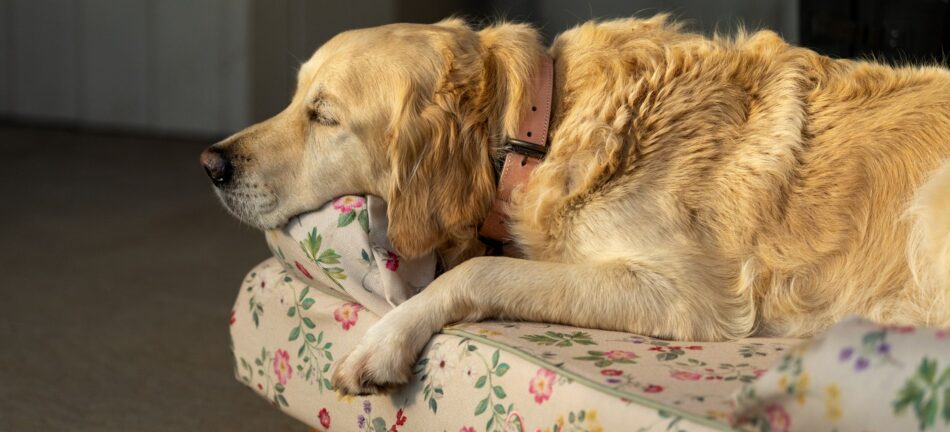
If you’ve ever visited a shelter or rescue, you’ve likely seen a wide variety of dogs of different ages looking for their forever home. But if you’re looking for a canine companion that’ll provide you with lots of love, fewer growing pains and a chance to slow down and enjoy life more, look no further than adopting an older dog.
Caring for a dog of any age requires work and patience. And while older dogs may come with a few more responsibilities than other rescues, don’t let those gray muzzles deter you. Adopting an older dog will save their life, but the rewards you get in return will be far greater. Let’s take a look at everything you should consider before adopting an older dog.
At what age is a dog considered old?
When it comes to a dog’s age, does it really matter? There are many misconceptions about how old a dog is when they reach their ‘senior’ years because a lot of the aging process is heavily dependent on the specific dog breed. Many believe that a dog is technically an older dog by the time they reach the age of 7 because of the infamous 7 to 1 human to dog years rule. In other words, a 7-year-old dog would equate to the age of 49 in human years by comparison. But we’re betting there are a lot of people in their late 40s who would argue they’re not yet old!
To really try and understand if a dog is an older dog, you can look at their breed-specific average age span and then calculate the last 25% of their life as being their senior years. So, for example, if a dog’s predicted life span is 11-12 years, then their senior years would likely start around age 8 or 9. Keeping in mind that these numbers are all averages and that every dog is different even among like breeds.
Why adopt an older dog?
The better question to ask yourself is why NOT adopt an older dog? Puppies and younger dogs are great, too, but with an older dog, you receive some extra benefits that are truly worth considering when looking to add another furry member to your family. Here are some reasons you should consider adopting an older dog:
- Already potty-trained: It would be rare to find an older dog that’s not already potty-trained. These dogs have been around awhile and ‘know the ropes’ better than their younger counterparts. So right out of the gate, you have one less basic skill to teach your new friend as they have likely already mastered it.
- Deeper connections: With age comes the knowledge of what it means to be loved by their person. Older dogs have a much better understanding of this concept, and as a result, are usually quicker to form a strong bond with you.
- Calm temperament: If you’re seeking a chilled canine companion who would rather snuggle on the sofa than chase you in the yard, then an older dog is where you should look. While older dogs still have energy to run and play, their puppy years are far behind them and they tend to be more relaxed and calm.
- Second chance matters: You can rest assured knowing that by adopting an older dog you will not only be rewarded with love and appreciation, you will also have the gratification of knowing you gave them a second chance. Every dog deserves a home filled with love and great care, and older dogs should be no exception to that.
Teaching an old dog new tricks
They say you can’t teach an old dog new tricks, but the truth is, you absolutely can! The amount of training an older dog has under their belt will vary, but they almost all have the basics covered. Training any dog requires patience and work, but chances are with an older dog, they will pick up on new tricks quicker as they tend to retain lessons faster than younger dogs and puppies.
Keep in mind that older dogs do come with older bodies, so they could get injured more easily if given new tricks that are too challenging or difficult. For that reason, make sure you really know what you are getting yourself into before adopting an older dog. Take time to research the specific dog breeds and ages that are best suited for your lifestyle before bringing home your new best friend.
Gentleness and patience are the keys to helping an older dog settle in. For many, these dogs may have spent the last few weeks, months or even years in a shelter so they will be entering your life with some expected nervousness or anxiety. Ensuring they have an easy transition into your home will require patience and time to let them get used to their new surroundings and routines.
Senior dog essentials
While every dog breed is different, most older dogs want to spend the rest of their best years doing what they love most – relaxing! So in order to make sure your older dog is as comfortable as they can be, here are some essentials you should have:
- Supportive dog bed: Just as mattresses are important to us as we age and change, so too are the beds that our dogs sleep on. And that is especially the case for older dogs. To give your older dog the most comfortable sleep, you need a supportive memory foam mattress that will provide the utmost comfort for their joints and muscles. The Topology dog bed, designed by Omlet, is not only a practical and stylish bed for your older furry friend, but it’s engineered with versatility for you to customize specifically for your dog!
- Temperature regulators: Like us humans, dogs tend to become more sensitive to temperatures the older they are. These senior pups are more susceptible to heat stroke and heat exhaustion as they age. So ensure they have a way to cool down fast when the temperatures rise by getting them a cooling dog mat that can be placed on their dog bed or directly under their bodies for immediate relief. And to keep them extra cozy and warm in the winter, make sure you have plenty of soft, snuggly dog blankets to snuggle with.
- Easy clean options: All dogs like to sleep but older dogs like to clock in a few more hours each day than their younger canine counterparts. Because your older dog will be spending more time snoozing, you want to make sure you have a dog bed that is easy to clean and care for so as not to disrupt their coveted nap times. The Topology dog bed toppers are a great option as they are machine washable and easy to clean. Keep an extra one on hand so you can make sure your dog always has a fresh set of sheets to zip on.
Omlet and older dogs
There really is no better gift you can give to a dog or yourself than by adopting. Whether you choose a puppy or an older dog, the rewards you receive in giving these amazing animals a good life are priceless. At Omlet, our mission is to make products that help bring you and your canine companions closer together. From dog beds, to dog bowls and every dog product in between, we want the designs that we create to be just as comfortable, supportive and enjoyable for your dog as your connection is with them.
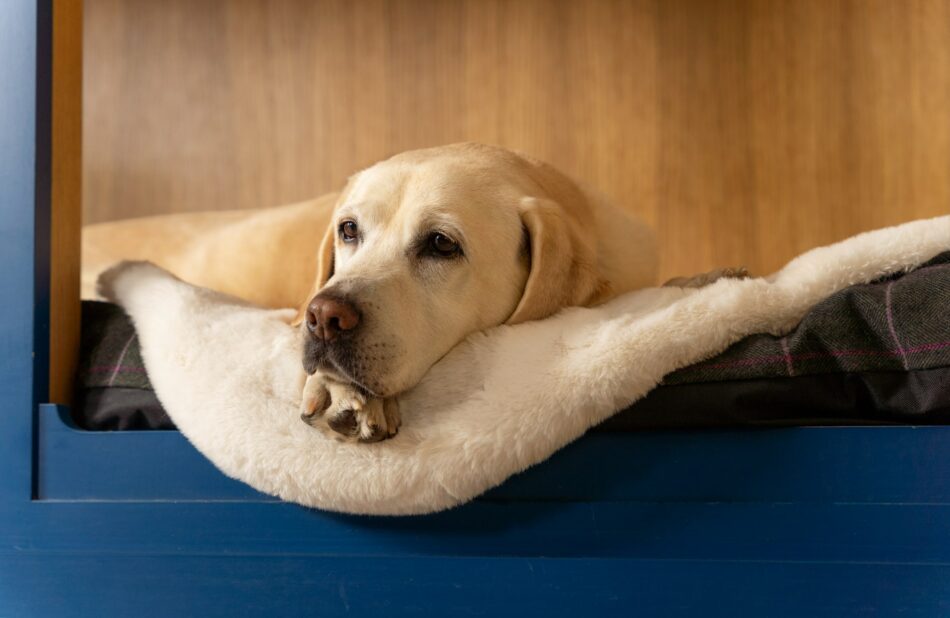
This entry was posted in Dogs
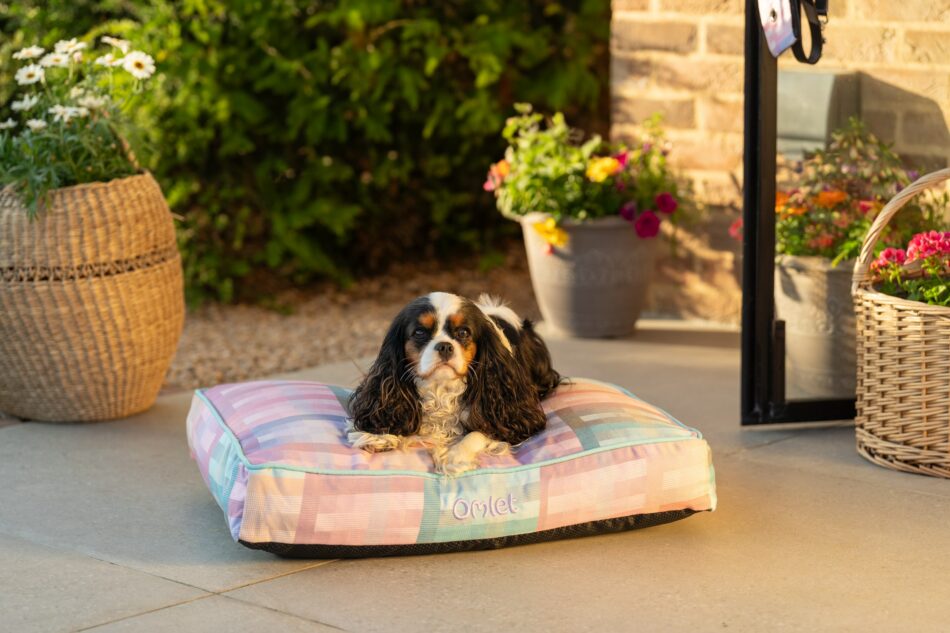
Every day we make choices that impact our environment and our carbon footprint. But what exactly does this mean? Without getting too scientific, the amount of carbon dioxide released into the atmosphere from the everyday things we do all equal up to an individual carbon footprint. Even our dogs have carbon footprints, or rather, carbon pawprints.
And just as you can make changes to your everyday routines to be more sustainable and reduce your carbon footprint, there are also ways you can help reduce your dog’s carbon pawprint as well. Even just small swaps here and there can have big positive impacts on the environment and those around us. So let’s take a look at some ways you and your dog can start living a more environmentally-friendly lifestyle.
What if a dog bed could live forever?
One of the biggest culprits to our planet’s carbon footprint is landfills. When waste piles up, over time, the disintegration of the trash combines to create gasses that are harmful to our atmosphere. One way we can do our part to reduce that negative impact is to throw less stuff away. And do you know what is one of the most common pet items thrown away each year? You guessed it – dog beds.
So we asked ourselves, what if a dog bed could live forever? What if we could make a product that would not only NOT end up in a landfill, but could stay comfortable and durable for the life of your dog? And then we crafted the solution. Designed as the forever sleeping solution for your dog, Omlet dog beds are not only curated with luxurious comfort, but they’re sustainably made to last a very long time.
With Omlet dog beds, you and your dog have a variety of options to customize your pet’s perfect sleep solution. When you purchase one of these dog beds, you receive a superior quality memory foam base that has the ability to be changed out with a selection of different fabric and color toppers. All toppers are machine washable so instead of throwing the bed away when it gets too dirty, simply wash the topper and your dog bed is back to new.
Reducing your dog’s plastic use
Raise your hand if you like to drink out of paper straws. Well, like them or not, the fact is that making a simple swap of paper for plastic in our drinking straws has a massive positive impact on our environment. And guess what? There are simple plastic swaps you can make for your dog as well to help reduce their carbon pawprint, too.
So the next time you need a new dog product, here are some more sustainable choices you can make:
- Dog bowls: What your dog eats and drinks out of is important not only to the environment, but to their health as well. Choosing a ceramic or melamine dog bowl, like Omlet dog bowls, allows your dog a cleaner way to consume their food and water. Keep them clean with frequent washing to keep the bowls around forever.
- Dog bed: We’ve already discovered a few dog bed options that allow you to clean the sheets and keep the bed. But what if there was a dog bed that stopped plastic going to waste? There is! Meet the Gardenia Collection dog beds designed by Omlet. With covers made from 100% recycled bottle fabric, these dog beds offer the ultimate environmentally friendly sleeping solution.
- Dog toys: Every dog loves to play with toys! But unfortunately, many dog toys are made from plastic. So try swapping even just one of your dog’s toys for a rubber dog toy option that is better for your dog and the environment! While these rubber toys aren’t 100% recyclable, they can be broken down into smaller pieces to be reused again!
Dispose of dog waste correctly
Owning a dog is one of life’s greatest treasures. Except when it comes to picking up their poop… While it may not be the most pleasant task, picking up after your dog is a task that must be done nonetheless. So how exactly can dog waste be eliminated differently to reduce your pup’s pawprint?
When out on a walk with your dog, what do you use to pick up their waste? Like most people, we’re guessing either a small plastic bag from your bag roll or just a plastic grocery bag. But guess where all of these plastic poop-filled bags end up? That’s right – back in the landfill. So to do your part in helping the environment and reducing your dog’s pawprint, simply choose different bags. You can pick from several options to include biodegradable, compostable and even leakproof paper bags. This simple swap may not make the task more enjoyable but it will make a huge difference to the environment.
Reconsider your dog’s grooming products
Sustainable and environmentally friendly products are not reserved exclusively for the items your dog uses every day. You can take the reduction of your dog’s carbon pawprint one step further by changing out the shampoo and conditioner you use next time you give your dog a spa day. By making small changes in your dog’s grooming routine, such as dog washes that are kinder to the environment, you will help your dog reduce their carbon pawprint even more!
Omlet and your dog’s carbon pawprint
At Omlet, we believe the connection between people and pets is something to celebrate. The products you buy your dog should matter to them, to you and to our planet. With a focus on quality and sustainability, we are able to make products that are both environmentally friendly and high quality, without compromising on comfort. From our Gardenia Collection designs, to our Topology beds to our selection of other sustainably made dog products, we continue to do our part to reduce carbon pawprints all over the world.
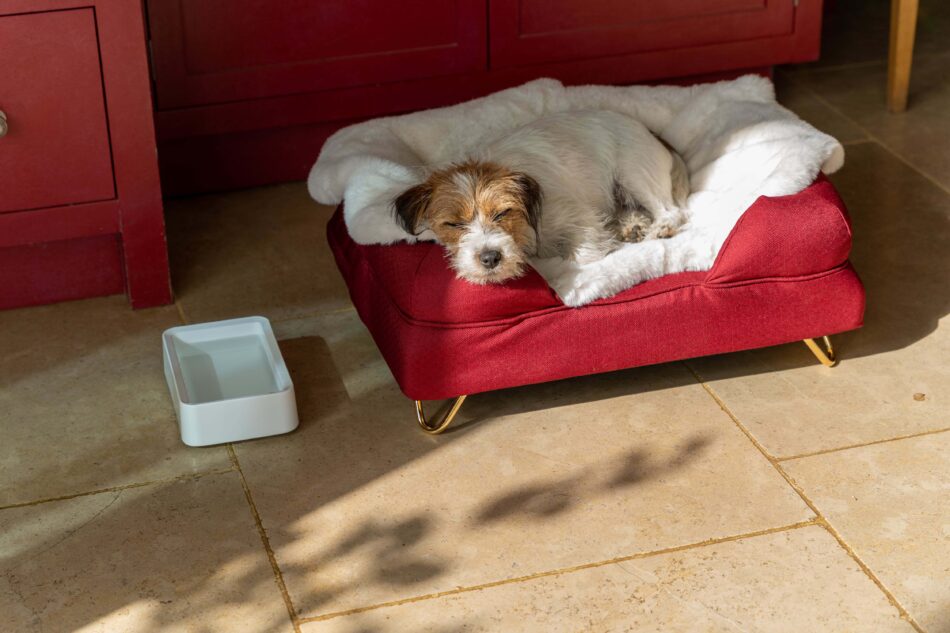
This entry was posted in Dogs

Considering crate training for your puppy or dog? While many people view dog crates as cages with cruel intentions, it’s actually been proven that dogs love a calm, safe place where they can rest and be by themselves. When introduced properly, crate training is an excellent way to give your dog a comfortable space of their own and help them learn new behaviors in the process. We’ve uncovered all the benefits and tips you need to know on when and how to use crate training as a tool and resource. Keep reading to learn more about crate training.
Why crate train?
Crate training is an important process in your dog’s life. Not only is it really helpful in potty training, but it’s also a great way to provide them with a secure space where they can retreat to in order to feel safe. So if you have a dog or new puppy in your life, take a look at all the ways crate training can be a useful tool in raising your new family member:
- Security: In the wild, dogs are naturally denning animals, which means they instinctively seek out small spaces to create a den-like feel. Offering your dog a crate to use at any age actually appeals to their innate behaviors and desires.
- Self-confidence: Think of how proud a toddler is when they learn how to use the ‘big potty’…the same is true for dogs! Through crate training, you set your pup up for success by helping them learn to reduce their wee and poop accidents.
- Self-reliance: As much as we wish we could spend every waking hour with our furry friends, the fact remains that sometimes we have to leave them at the house alone. When you crate train your dog, you give them a stronger sense of confidence to be ok by themselves when you have to be away from them for a while.
- Privacy: A dog crate can serve as a very useful time-out device for overtired puppies who need a break. It’s also a great place for your adult or senior dog to escape to when they want to be alone.
- Practicality: Being comfortable with a crate is important for dogs as they will be exposed to one eventually. Whether at the vet, the groomer or traveling in a car, crates are often used in other places to keep your dog safe and secure. So best to get them comfortable with a crate at home first.
Make crate training an enjoyable experience
A dog crate is meant to be a positive environment for your dog to see as an enjoyable place to be. The best way to ensure they have this association is to create that positive feeling from the moment of introduction to the crate. Here are some ways you can make crate training a truly enjoyable experience for everyone.
Choose the right crate
Finding the best dog crate is key to the success of your dog learning to love it. Depending on what dog breed you have, you want to make sure the crate fits your dog’s size and ability to turn around while in it. Other features your dog crate should have are durability, comfortability and transportability. The Fido Nook dog crate is a wonderful option as it provides all of these features while also doubling as a sleek piece of furniture in your home.
Create a positive association
One of the fastest ways to a dog’s heart is through their stomachs. So in order to encourage a positive association with the dog crate, use food and dog treats as tools. You can even move their dog bowls closer to the crate so they see the positive connection of eating and crate naps so close together!
Create a comfy spot
Some dogs prefer laying on hard surfaces and might be quite content just napping on the bottom crate tray. However, most dogs (and their owners!) prefer a more cozy spot to sneak away to. Try a comfortable plush dog bed that fits inside the crate so they can have more padding to snooze on. Or, just lay down a few cozy dog blankets so your dog can create the nap nest they desire.
Play crate games
It’s completely normal for dogs and puppies alike to be uncertain of a crate at first. How would you feel about seeing something so foreign and new for the first time? One of the best ways you can make crate training a less scary experience is by making it fun – and what is more fun than playtime? Get on the floor and use different dog toys to throw in and out of the crate to encourage a fun and playful game that makes your dog more comfortable with the new space.
Have patience
Any dog can learn new tricks and that goes for crate training, too. But only if you have patience and take it slowly. Like anything new, if you rush the process it is unlikely to stick, which can lead to frustration for you both. So take your time and allow your dog to warm up to the crate in their own time. Before you know it, they will be sneaking away to it all on their own!
Omlet and crate training
At Omlet, we believe having a dog is more than just owning a pet, it’s a relationship that is to be fostered. So we design our products to cultivate that connection so you two can spend more time together building those bonds. We believe crate training is an invaluable tool and while we didn’t invent the dog crate, we did perfect it. The Omlet Classic Dog Crate is engineered with durable welded steel and two door options for easy placement and openings. Use it by itself or place it inside the Fido Nook, for a more sleek and modern design that complements your interior. Whichever option you choose, Omlet can help make crate training your dog an easy and enjoyable experience.
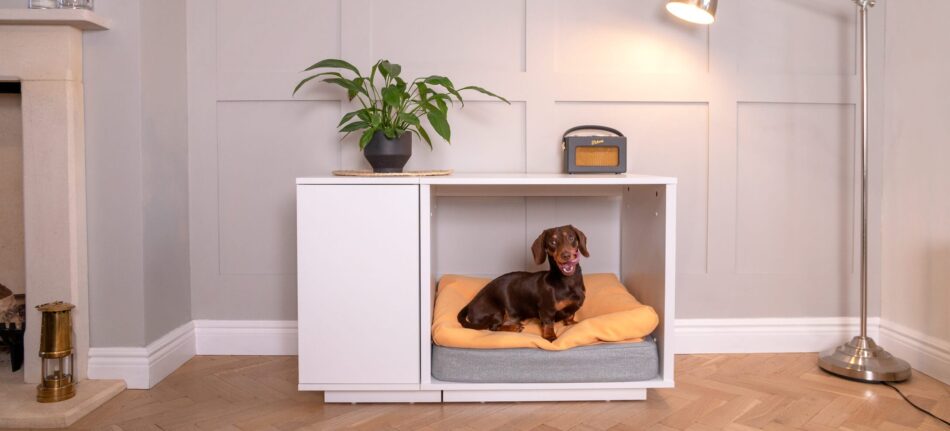
This entry was posted in Dogs
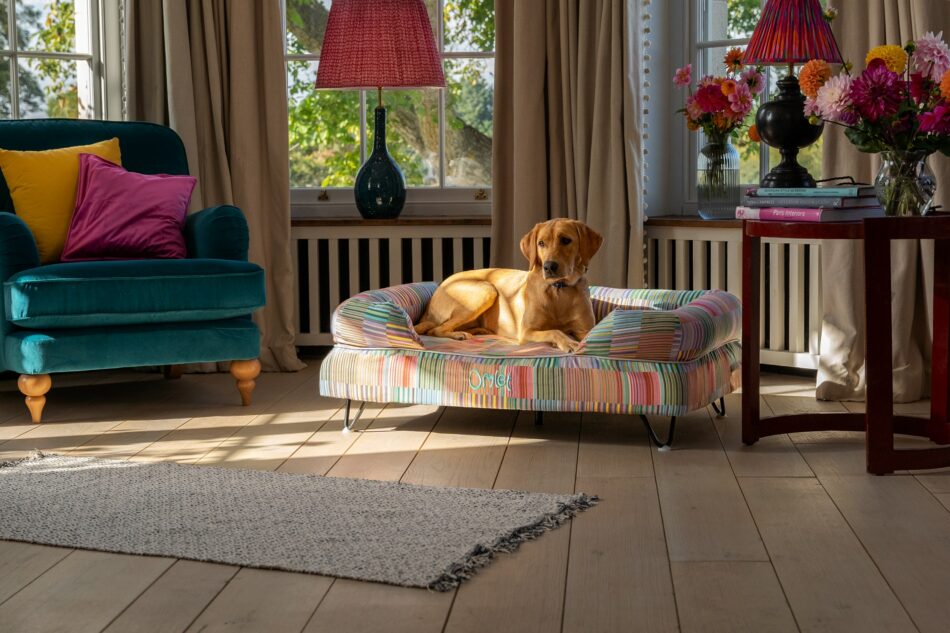
Every dog owner has their own version of their favorite dog walk. Through dense green forests or busy city streets, across pebble paths or rocky trails, every day we walk in step with our loyal, canine companions. This was the inspiration behind Omlet’s first limited edition collection of designer dog beds and signature prints. The Dog Walk Collection reflects the places we travel with our beloved dogs, to be remembered long after the walk is over.
Step into our world of walking wonder and unearth the journey of our first limited edition dog bed collection, designed by Omlet.
Meet the designer
Omlet’s in-house textiles designer, Victoria, is the ideator behind our first, limited edition collection of signature prints. As a dog owner herself, Victoria drew inspiration from the connection and companionship between dogs and their owners. Dog walks unite us in a shared experience, as we all travel in different paths but with collective joy. It was from this inspiration that the signature prints of the Dog Walk Collection were first sketched.
In this exclusive behind-the-scenes video, Victoria guides you through the origins of the designs and the step-by-step process of how she came up with each print. Follow along and uncover more about these unique and signature designs – which print suits your dog and their favorite walk best?
Inspiration for the patterns
Does your favorite dog walk reflect where you live, who you interact with and what makes your dog’s tail wag? We know everyone walks different paths and sees different sights, but ultimately, we all experience the same joy of spending quality time with our dog. Learn more about the walks illustrated in our 8 signature designs of the Dog Walk Collection and which connects with you most.
- Nature Trail: Born from the images of a serene walk in a deep green forest with soft teal tones.
- Pawsteps Electric: Influenced by the movement of paws and feet in the hustle and bustle of city life.
- Pawsteps Natural: Echoes the pace and peace of people and paws walking through cobblestone streets.
- Contour: Inspired by the hound who finds gratitude in every hill and hike alongside their companions.
- Morning Meadow: An experience of the glow of sun soaked fur and the smell of sweet scents of wild flowers.
- Midnight Meadow: Deep, rich floral tones are reflected in this slumber ready design.
- Forest Fall: Towering oaks and windswept walkers were the inspiration behind this print.
- Shaded Spruce: The only singular color of the collection, this vibrant and rich hue serves as the heart of our signature prints.
Meet the Pawsteps
The unique patterns of the Pawsteps Electric and Pawsteps Natural prints are inspired by the movement of two and four legs in unison together. Some dog walks are fast, some are slow, some walks are with big dogs and others with small. But all dog walks are a time well spent with the ones you love most. And that was the vision behind these signature designs.
A juxtaposition of prints and places, the Electric print showcases fast walks in big cities and urban jungles where vibrant colors envelop the scenery. And the Natural print reveals the same movement of steps but in a more quiet place like small, quaint villages where time feels to go by slower.
Both of these prints are available in our new bed designs, the Cushion Dog Bed and the Nest Dog Bed, as well as Omlet’s best-selling, memory foam Bolster Dog Bed.
Walk in the Meadows
One look at the Meadows patterns will leave you feeling like you were lost in a field of wildflowers. These floral designs give you a sense of total immersion within a countryside where pastures, hedgerows and flowers all bloom with fragrant beauty.
While both designs reflect an almost scratch and sniff sense of wonder, they are uniquely created to illustrate the day and night paths that may be walked. In Morning Meadow, the vibrant colors of dog-roses and winter berries pop all over the print. And Midnight Meadow gives way to the feeling of sundown on the same bountiful countryside where a full day of adventure peacefully comes to a close.
Choose from three styles of bed, cushion, nest or bolster, for your dog’s rest in the meadows.
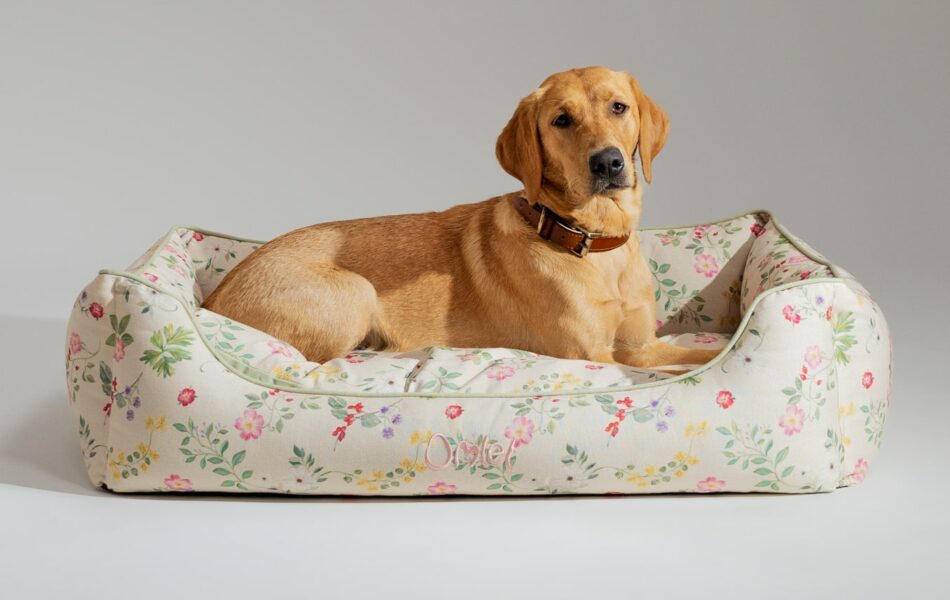
Fall for nature
If a walk amongst the trees and rich colors of the forest are what you and your canine companion love most, then the vibrant tones and patterns of Nature Trail, Contour, Forest Fall and Shaded Spruce will match you best. Designed from the feeling of being immersed in the natural essence of nature, each print is created to reflect the beauty of walks through tall trees and soft hues.
Both Nature Trail and Forest Fall create the feeling of a favorite path meandering through lush, green trees where the wind gently embraces your skin and fur. By contrast, the Contour print elevates the height of wonder with the same tree-lined path that now twists and turns on the hillside. And all of the rich teal tones that are seen stroked through your walk are captured in the only singular color print of the Collection, Shaded Spruce.
Discover your favorite path to walk in one of these prints available in our three styles of bed, cushion, nest or bolster.
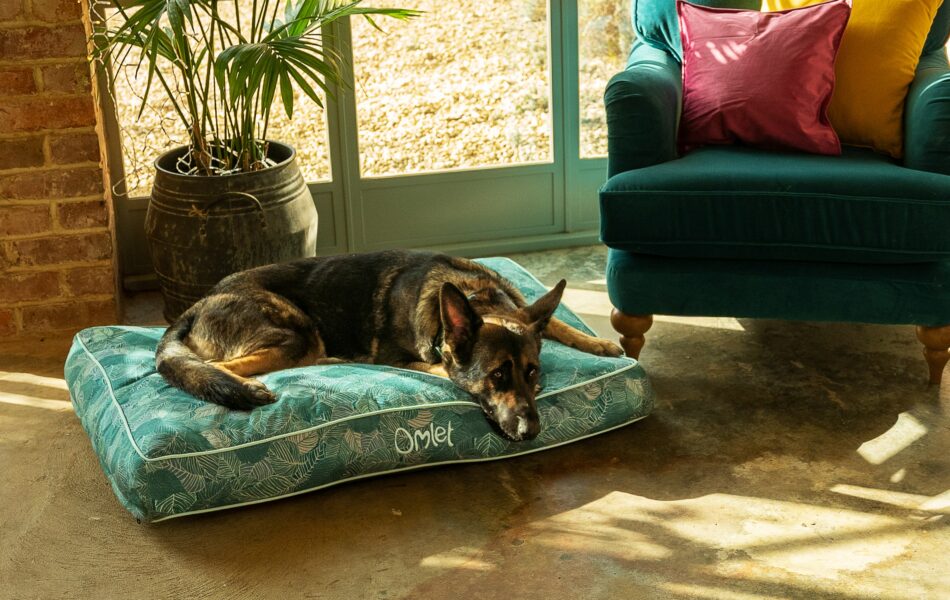
Let’s talk sustainability
At Omlet, we are committed to designing innovative products that are both durable and comfortable. Creating products that can be repaired, recycled and easily cared for are part of our mission to improve sustainability in the pet industry.
With our new signature print collection, we have made significant steps to a more sustainable dog bed, without compromising the quality of comfort. The dog bed covers in the Dog Walk Collection are made from 100% recycled bottle fabric. These bottles are turned into a yarn and woven into our luxurious and hard-wearing canvas fabric that is comfortable for your dog to rest on.
We meticulously researched and tested the use of recycled polyester for our dog bed stuffing but found the quality of the end product to be unsatisfactory for your dog. The stuffing flattens and loses its bounce quickly, compromising your dog’s comfort and reducing the longevity of the bed. This is why we decided to use virgin polyester to produce a high-quality, long-wearing and comfortable bed for your dog to use for many, many years to come.
We strive to make continued sustainable swaps to help you and your pet leave a smaller carbon pawprint on the world, and we’re proud to be making conscious and planet-friendly decisions every day.
Explore the Omlet Dog Walk Collection
A dog walk is more than just a stroll with your pet. A dog walk is a celebration of canine and companion as they share a joyful experience within the unique beauty that surrounds them. We invite you to explore the 8 limited edition, signature designs of the Omlet Dog Walk Collection and find a pattern that best celebrates your favorite walk with your dog. After all, the paths we walk may be different, but your dog’s path home to their bed is the one they look forward to the most.
This entry was posted in Dogs
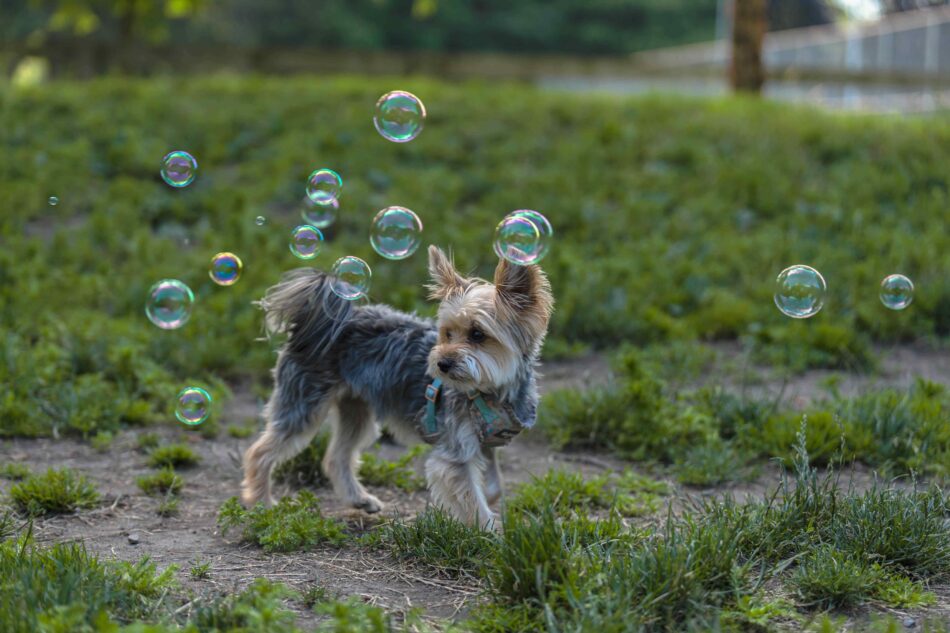
Your dog has lots of energy and loves to run and chase things. Be it toys, sticks or a slobbery tennis ball, the act of chasing is an innate trait in dogs. But has your dog ever chased after bubbles? An enriching game of running, chasing and jumping after bubbles is one of the best ways to engage your dog in mental and physical activity! With easy to make DIY recipes, tips and tricks, we have everything you need to know on how to make dog-safe bubbles.
Do dogs like bubbles?
What dog doesn’t like chasing after a soapy floating orb of water and popping it with their wet nose? For most dogs, playing with bubbles is as fun as any other playtime activity! While certain dog breeds may enjoy the challenge of chasing bubbles more than others, there’s no denying that every dog receives the benefits of brain/body coordination and physical movement when playing with a bubbly concoction!
Think about the last time you blew bubbles for your child or even just for yourself. There was running, chasing, jumping and lots of fun involved! The same is true with dogs and bubbles! It’s a highly engaging activity for dogs that entertains the focus of the mind and the movement of the body! And bonus – playing with bubbles means you get to spend more time with your furry best friend!
Are regular bubbles safe for dogs?
Go to any toy store or party store aisle and you will find every color, size and scent of bubble solution available. But are store bought bubbles safe for your dog? We don’t recommend them. Here are some important facts to consider when it comes to buying ready made bubbles for your dog:
Even though packaging is labeled “non-toxic”, it can still contain some ingredients that are harmful to your dog. Some of the chemicals used in ready made bubbles are harmless to humans but could cause chemical burns or upset stomachs for your pup, especially if your dog likes to pop the bubbles with their mouth!
Dogs like to lick in order to sense the world around them. So an accidental spill of store bought bubbles could mean lots of harm for your dog if ingested. It’s always important to remember that when using any substance around your dog, harmful or not, to keep at a safe, out-of-reach distance to avoid any disasters!
There are now a variety of “dog specific” bubbles on the market, complete with meat and bacon flavors! However, be sure you read all the ingredients before purchasing. Even with these special made solutions, there can sometimes be a remnant of ingredients that will still pose a danger to your dog if ingested.
DIY dog-safe bubble recipes
With too many unknowns that come with store bought bubbles for your dog, it’s best to stick to at home recipes that you can make yourself. Not only are these DIY bubbles inexpensive and easy to make, but they are safe for every member of your family to play with – two and four legged alike!
The following recipes all include dish soap and it’s important to note that the amount used will not harm your dog in bubble form. However, still adhere to the “keep out of reach” rule when playing with these bubbles as an accidental ingestion of the entire solution could cause your dog some serious GI issues.
Simple solution
1 cup water + 1 Tbsp dish soap (ex: Dawn)
Combine together in a bottle or dish until well mixed.
Advanced solution
½ cup biodegradable dish soap (ex: Seventh Generation) + 1 cup water + 1 tsp glycerin
Mix together in a resealable container and store overnight for best results.
Flavored solution
1 cup water + 2 Tbsp castile soap + 1 Tbsp glycerin + 1 tsp bone broth
Mix well in an airtight container and let it stand overnight before using.
Now that you have the bubble solution, it’s time to make bubbles! You can use a variety of household items to help create the popping party – straws, strainers and even whisks all work well at creating bubble magic! You can even bend a paperclip into a rounded shape to try and mimic a traditional bubble stick! No matter how you choose to make bubbles, your dog’s going to love it!
How to introduce your dog to bubbles
Just as with any new experience, some dogs may be initially confused with bubbles. Can you remember the first time you saw these tiny water circles floating around you? It was strange wasn’t it! So be patient when first introducing your dog to bubbles. Let’s check out these helpful tips:
Doggy see, doggy do: One of the best ways you can show your dog that bubbles are tons of fun is by chasing them yourself. When they see you having fun, they will quickly understand they can, too! If you have kids, get them in on the fun as well and before you know it, the whole family will be chasing bubbles around!
You can also get down on your dog’s level and gently blow a few bubbles so they can get a better viewpoint. Hold a bubble in your hand and pop it with your nose so your dog can experience the wonder of this activity.
Bubble machine: If you have kids, you’re in luck!, because that means you most likely have a bubble machine. And when it comes to making bubbles for your dog, what better way than with one of these! All of the homemade dog-safe bubble recipes are ok to use in a machine and will make your job much easier on producing bubbles!
Safety measures: All dog-safe bubbles contain soap – and soap is slippery! So to avoid any potential slips or falls, it is best to have your dog play with bubbles outdoors. If indoors is the only option, be sure to do the activity on a non-skid surface so fido doesn’t lose footing! Be sure to also pay close attention to your dog when playing with bubbles and never leave them unattended. Too many bubbles near the eyes means irritation for your dog, so if you see them acting uncomfortable, immediately wipe away any soapy residue before you resume play!
Seeing your dog chase, jump and snap at bubbles is not only entertaining, it’s also great exercise! But if for any reason your dog doesn’t find the fun in bubble play, or gets bored with them quickly, you can always encourage continued play with dog toys! And don’t forget to have a comfortable dog bed for fido to rest on when all that bubble playtime is over!
This entry was posted in Dogs
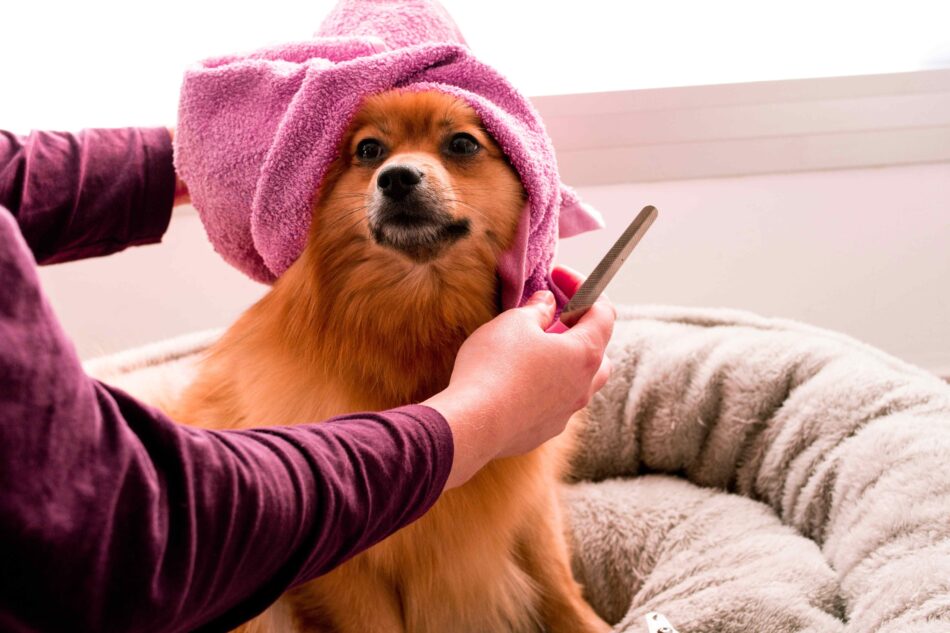
Everyone deserves a day of tranquil relaxation! When the stresses of life get hectic, treating yourself to a day at the spa can make all the difference. But do you know what’s even better? Treating your best four-legged friend to a spa day! That’s right – pampering your pooch not only benefits your dog with de-stressing relaxation, but the act of giving an indulging wellness experience will bring you and your pup closer together. Here’s everything you need to know on how to give your dog a spa day.
Setting up the spa environment
When planning to treat your dog to the ultimate escape of calm and serenity, you first need to make sure you have the spa essentials on hand. Does your pup just need a blissful bath or will they get a massage and pawdicure as well? Decide ahead of time exactly what spa specials you want to give your pup and then gather the shampoos, nail trimmers and brushes all together so you have them in one place.
Next, pick out the perfect place to pamper your pooch! Whether it’s in a large bathtub, walk-in shower or outdoor lanai, make sure the spot you pick is quiet and calming. This will ensure the spa experience is relaxing. You can even play some soft music, such as classical or nature sounds, to add another layer of tranquility.
If this is the first time you are treating your special friend to a spa experience, it’s a good idea to have one of their favorite dog blankets on hand to help them stay at ease. Some dogs are unsure about new things and having a familiar scent and snuggle will allow them to enjoy the spa day much more quickly!
Now before you begin the spa day, you want to be sure you give your dog a bit of exercise first to get them nice and tired. Help your dog ease any jittery feelings by taking a brisk walk around the block or playing a game of fetch. Giving your dog a workout beforehand will help keep you from having to workout too hard trying to keep them still during the spa! A relaxing spa day is the perfect reward after some exercise!
Doggy massage
Who doesn’t love having their sore muscles massaged? Dogs carry stress and strain in their joints and muscles just like we do. So spending time gently massaging your dog can provide continuing benefits of relief and relaxation for your pup long after the spa day is over! Here are some tips on how to give your dog the ultimate spa massage:
- Always start slowly and with gentle pressure when giving your dog a massage so they can get used to the experience.
- Begin the massage by using your thumbs to make small, circular motions on your dog’s head.
- If your dog is maintaining a relaxed state, slowly work your way onto their shoulders and down their back by applying the same gentle pressure.
- Your dog may decide to roll over and request a belly rub, which is completely normal! Feel free to scratch that tummy while also massaging through any tension points.
The massage portion of the spa day may last a few minutes or more depending on your dog’s temperament and comfortability with the new experience. Pay attention to your dog’s body language and adjust accordingly so the massage remains a positive experience. Before long, your dog might just be begging you for more!
Blissful bath time
For some dogs, the ‘b’ word can be a dreaded sound that means “run for cover under the bed”! Your dog’s hygiene is vital for their health but bathtime doesn’t have to be a bad time! Creating a welcoming and calm environment is the key to success with spa day baths. Follow these essential bath time tips and your dog will start running for the tub instead of the covers the next time they hear the ‘b’ word!
- Since the bath is the spotlight of the spa day, you want to be sure you have the water temperature just right! Keep it on the warm side and add some soothing scents of lavender or chamomile oils to make it more inviting. Spa day baths should not be done with the outdoor water hose!
- Slowly introduce your dog to the bath – nobody wants a spa day to feel rushed! Once you can see that your pup is relaxed and ready to be pampered, you can slowly begin wetting down their fur.
- Apply generous amounts of shampoo onto your dog to create a luxurious lather. This is the part of the bath experience where you can really create that calming effect by gently massaging in the shampoo and getting them clean!
- Once rinsed off, towel dry your dog completely from head to tail. When done right, your dog will look just as good as they smell!
Doggy spa day baths are the best part of the experience! Not only does your dog get a soothing and relaxing treatment, but you get a clean and fresh smelling dog!
Pawdicure and proper grooming
No doggy spa day is complete without the final touches of a pawdicure and brushing! Depending on your dog’s breed and coat, you may need to spend a little or a lot of time brushing them. But even just a regular dog brush can work wonders at removing dead hair and redistributing skin oils throughout their coat. Maintaining a regular grooming schedule for your dog is essential not only for spa days but throughout the year!
When it comes to nail trimming, dogs and pet parents alike can become hesitant! But more than for just looks, keeping your dog’s nails trimmed is important in making sure they can walk and run without issue. How do you know if your dog’s nails need to be trimmed? The best rule of thumb is to listen as they walk on a hard floor – if you hear the click-clacking of nails, it’s time for a trim!
If trimming your dog’s nails on your own, be sure to start out small, only cutting away tiny tips at first. You can even use a doggy nail file to more swiftly whittle down the excess length. However, if giving your pup a pawdicure is not something you are comfortable doing, you can always seek out the assistance of a professional groomer to help!
Your dog gives you unconditional love every day! So pampering your pup with a relaxing massage, bubbly bath and essential grooming is one of the best ways you can show them the same. A doggy spa day means spending more time with your dog and that will make the experience that more special. Your dog is a big part of your world, but to your dog, you are their whole world! So give them a spa day to show them how much you care!
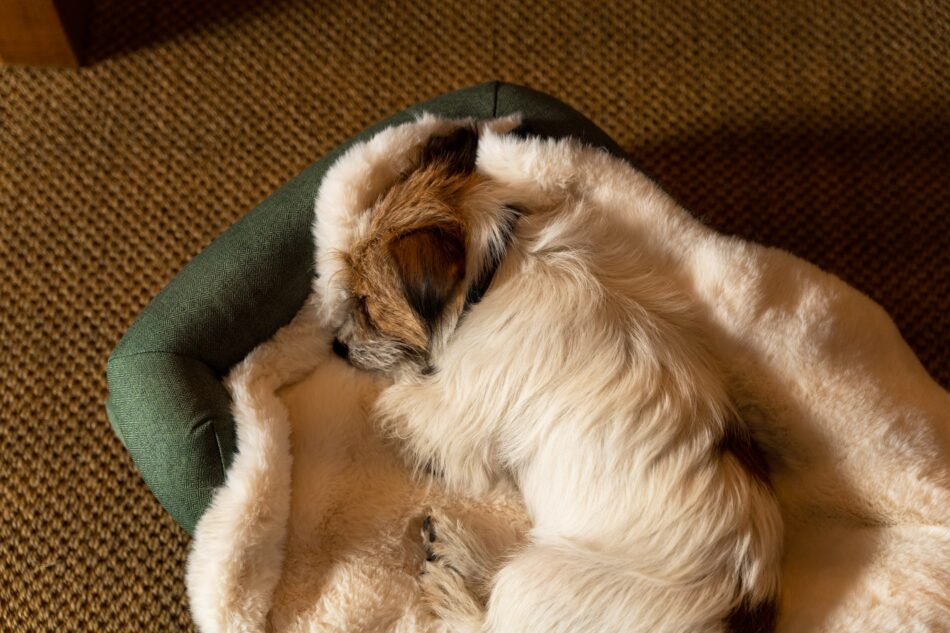
This entry was posted in Dogs

Creating a doggy obstacle course at home is much easier than you think! You already have materials in and around your house that can be used for agility and provide your dog with the incredible benefits of physical exercise and mental stimulation. And any activity that involves you and your dog working together is sure to build a closer bond between you both! Start your obstacle course today with these simple tips and tricks!
Can all dogs do agility?
The great thing about agility training is that every dog breed can do it! The only exceptions to this type of activity would be puppies younger than 12 months due to their still developing joints or any dog that has a medical condition, such as arthritis. But, if your dog falls into one of these categories – there are still many ways you can keep your dog active and stimulated!
So what exactly is agility? Simply put, agility is a series of obstacles paired together to form a course for your dog to navigate through with direction. It doesn’t matter if your dog has training experience or not – you can start easy and small and work your way up as you and your dog learn more.
You love spending time with your dog and creating an obstacle course is just one more way to bring you both closer together! As with any new activity, if you have any concerns about your dog’s ability to participate, consult with your vet first to be sure.
Safety first!
Before getting started creating your at home doggy obstacle course, you want to make sure you pick out a location with enough space to allow room for lots of movement. This may be indoors or outdoors depending on your home and backyard. The most important thing to remember in keeping this activity safe for your dog is to remove any objects from the area that could potentially hurt your dog or get damaged. After all, your dog will be running and jumping!
Now that you have your course location picked out, you want to make sure your dog is familiar with listening to and following commands. Any doggy obstacle course is only as good as the human that is verbally navigating where to go, so make sure you practice simple commands so you both are comfortable and stay safe. Your dog doesn’t have to become a professional but a simple understanding of commands such as sit and stay are a great starting point!
Once your obstacle course is set up, you want to make sure you give your dog a good warm up before running through it. You wouldn’t try a new physical activity without first properly stretching, right? The same goes for your dog! Just a quick walk around the block or a game of fetch will suffice to warm up your dog’s muscles to safely enjoy the obstacles.
Hurdles and jumps
If you and your dog are new to obstacle courses, jumping is a great first activity to try. But how do you know what height to set your jumping bar to? It all depends on your dog! Smaller dogs, like Chihuahuas or Dachshunds, only need a short height to try and clear while bigger dogs, like Labradors and German Shepherds, should be able to jump over higher obstacles.
So what can you use to create a hurdle for your dog to jump over? Here are some great ideas with materials you likely have at home already:
- Grab two laundry baskets and a curtain rod. Place either end of the curtain rod onto each laundry basket and, voila! You have a jumping hurdle! Move the rod up or down for varying heights depending on your dog’s ability.
- Have any PVC pipes laying around from an old plumbing project? These make a perfect tool to make a hurdle of any height!
- Check your beach bag for a leftover pool noodle – they make great jumping hurdles! Not only are they soft, they are also easy to hold for your dog on their first obstacle run!
There are countless options that can be used to create a DIY hurdle for your doggy obstacle course. Just make sure they are lightweight or soft so they do not hurt your dog in all the fun. And if your dog has never jumped over a hurdle before, you can encourage them to explore the new activity with dog treats or verbal commands. No matter your dog’s age, you can teach them new tricks!
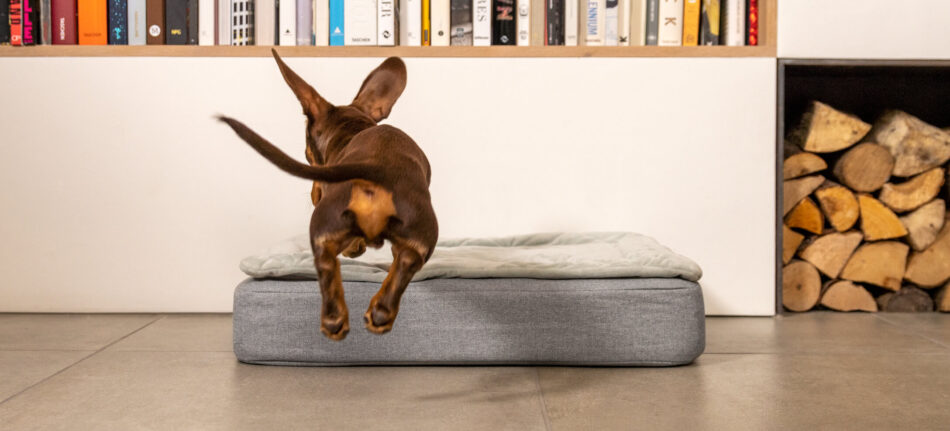
Zig zag
Next, you can move on to the weaving portion of your obstacle course. Similar to the hurdle portion, you want to make sure the materials you use for the zig zag are lightweight or soft to avoid your dog getting hurt!
Let’s take a look at some options to make a zig zag obstacle for your dog.
- If you have kids, you likely also have some small orange play cones as well. These make a great option to set up a zig zag for your dog’s obstacle course! Start spacing them out far apart to allow your dog plenty of room to navigate. As your dog gets better at weaving you can slowly move them closer together.
- Not sure what to do with all of your leftover cardboard boxes? Use them to make the perfect weaving obstacle! Not only are boxes lightweight and easy to set up, but if your dog crushes them in their run, you can simply break them down to recycle.
- Did you know some Christmas decorations make a perfect zig zag obstacle for your dog? Before you put away your plastic candy canes from the yard, try using them as part of the course. These lightweight poles are a great option to train your dog to weave in and out of.
Start out slow when teaching your dog to weave in and out of any object. With consistency of hand and verbal commands, your dog will quickly learn this new and fun activity!
Tunnels
The tunnel portion of the obstacle course may be the most intimidating for your dog if they’ve never done agility training before. One of the best ways to help your dog learn? Make sure you navigate the tunnel first to show them how it’s done!
Creating the perfect tunnel obstacle for your course is as easy as setting up items you have around your house. Here are a few options to choose from:
- Line up some chairs and drape a lightweight blanket across them. Now you have a tunnel! Show your dog how to go under the chairs by crawling through yourself so they can follow the fun! If your dog is of bigger stature, you may need taller chairs or pick a different option.
- Do you have a collapsible fabric tunnel that your kids climb through? Your dog can use this fun toy, too! Get the whole family in on the fun of a doggy obstacle course by having your child show your dog how to crawl through the tunnel first.
- Those large cardboard boxes can be used once again! Open up both ends of the box to create a square-shaped tunnel and watch your dog run in and out with ease.
While some dogs may enjoy running through tunnels more than others, agility training is an enriching experience for every dog!
Putting it all together
Once you have created each individual obstacle, you can start to put them all together to create the ultimate course! Be sure you have practiced the hurdles, zig zag and tunnels all separately before you set them up in any sequence. This will ensure your dog is familiar with what to do.
You can set up the course any way you like! Does your dog like the zig zag the best? Put that obstacle at the start of the course to encourage movement through the rest of the obstacles. Once you have created each separate obstacle you can move them around to try different combinations and course options!
The trick to any successful doggy obstacle course experience is patience, consistency and fun! And having plenty of dog treats on hand will help to encourage activity and reward hard work! Creating an at home obstacle course is a great way to add exercise to your dog’s life and create a closer connection between you and your best friend!

This entry was posted in Dogs

If you’ve ever given your dog a Kong you know how fantastic these indestructible toys are at keeping your pup active and stimulated for long periods of time. Not only are they great for games of fetch, but they’re also great for stuffing yummy treats inside to encourage mental agility with reward! To better help your dog’s natural instinct of hunting food, here are some delicious recipes you can make to stuff inside your dog’s Kong.
Kong benefits
Before we dive into the treats, let’s first explore why Kong toys are so beneficial for dogs in the first place. The hard rubber chew toy was first invented over 40 years ago by Joe Markham as a way to stop his German Shepherd from chewing up all his socks. Since then, dogs all over the world have enjoyed the fun of a Kong toy. It not only encourages positive chewing habits, but also improves oral health.
For dogs who are prone to separation anxiety and being left alone for too long, the Kong is also a great way to keep their brains distracted and engaged. Dogs are innately programmed to chew – it’s how they search out the world around them. So having a toy like the Kong that is virtually indestructible is a great way to keep your dog busy and happy.
The Kong was specifically designed with a hole in the middle to house treats and encourage a dog’s natural instinct to hunt for food. The act of hunting the food out of the Kong provides dogs with increased mental stimulation that is super beneficial to their overall growth and development. We know it’s important to maintain a well-balanced diet for your dog, so adding these small, healthy treats to the Kong will provide the benefits of good nutrition and activity.
Puppies and Kongs
The Kong makes for the perfect puppy chew toy, which you can even purchase in puppy size. Not only will a Kong help prevent their piranha puppy teeth from chewing on what they shouldn’t be i.e. your favorite pair of shoes, but will keep them mentally stimulated, where they’re unable to get as much physical exercise from long walks at such a young age. Ultimately though, puppy chewing is unavoidable and they’ll often find themselves chomping on anything they can get hold of to help with teething – including their beds.
But, at Omlet, we’re committed to putting an end to demolished beds and disturbed doggy sleep. So, we took matters into our own hands and designed the Topology puppy bed – perfect for withstanding razor-sharp teeth, puppy accidents, and everything else in between, whilst never compromising on comfort. And if your puppy somehow manages to chew through their Quilted topper? We’ll replace it for free*. With all being said, we still strongly encourage you to redirect your puppy’s chewing with dog toys such as the Kong to help them channel their exploration of the world around them.
Now, onto the recipes…
Recipe #1 – Savory Snacker
For the dog who craves the savory tastes and smells of meat, this recipe is sure to get the tails wagging. These ingredients are staples of most households and the recipe is simple to make.
- Take one small sweet potato and microwave or bake it until it is soft in the center. Once cooked, let it cool for a few minutes. Then, scoop out the inside of the potato into a bowl and mash with a fork to get any lumps out.
- Next, boil plain chicken until thoroughly cooked. You want to make certain this meat is not seasoned as some spices can be detrimental for a dog to ingest. Once the chicken is completely cooked, fork shred a small piece into smaller bite sized pieces and add it to the bowl of sweet potato.
- Last, shred one small carrot into fine pieces and add it to the mixture.
- Stir all ingredients together until they mix and marry completely.
You can add the mixture just as it is to the Kong from here or roll into small balls and place in the freezer for a frozen savory treat later. Either way, your dog will love hunting down the savory morsels of this yummy treat.
Recipe #2 – Sweet Treat
Did you know that dogs have a sweet tooth just like we do? While the taste buds of a dog are a fraction of that of humans, their smell is a million times stronger. And when dogs smell the delicious, sugary scents of sweet food they can’t help but indulge. So if you want to treat your sweet pup to a sweet treat, here is a recipe that is sure to have them begging for more.
- Take one cup of plain greek yogurt and put it into a bowl.
- Next, add two large tablespoons of any nut butter – peanut, almond or cashew are some great options. Whatever you have on hand in your pantry will work.
- Finally, chop up fresh strawberries into small bits or mash up some fresh blueberries into a fine mixture. The sweetness of the fruit is what makes this treat so indulge-worthy.
- Now mix all the ingredients together and then smooth out the mixture onto a parchment-lined pan. Place the pan in the freezer for at least 2 hours so it can completely harden. When you are ready to stuff the Kong, simply break off a piece and place it inside.
This sweet treat is sure to provide hours of engaging activity for your dog – with a delicious reward for their work.
Recipe #3 – Dinner Delight
Is your dog an “invite me to the dinner table, too” kind of dog? If your pup has a hard time keeping their nose (and their mouth.) away from the dinner table, this Kong stuffed recipe is sure to occupy their time so you can enjoy a peaceful meal.
- About one hour before your dinner is ready, boil one cup of rice until tender and add to a bowl to let it cool.
- Take one can of plain salmon canned in water and drain it into a strainer so only the salmon meat is left. Mash the salmon into small pieces with a fork and add it to the cooked rice.
- Next, finely chop up some fresh spinach and mix it into the rice and salmon mixture.
- Depending on the size of your Kong, take one spoonful of the combined ingredients and spoon it into the Kong. Then place the stuffed Kong into the freezer.
When you’re ready to eat, take the Kong out of the freezer and give it your pup. We guarantee they will be happily entertained and licking away for the entirety of your dinner, if not longer, with this frozen, delicious treat! And you will have enough of this recipe leftover to make more Kong dinner treats another time.
The Kong toy is a favorite of so many dogs and pet parents because they are easy to stuff with store bought treats, or allow you to create your own recipes. Making homemade treats to stuff in your dog’s Kong is as easy as combining a base, a protein and an add-in. Some other simple ingredients to consider are cottage cheese, yogurt, peanut butter, ground turkey, and apples. No matter what treat you make your dog, be sure to have a sturdy and easy-to-clean dog bowl on hand so they can eat any leftovers without much mess. Try out one of these recipes today and let us know how your dog liked them in their Kong!
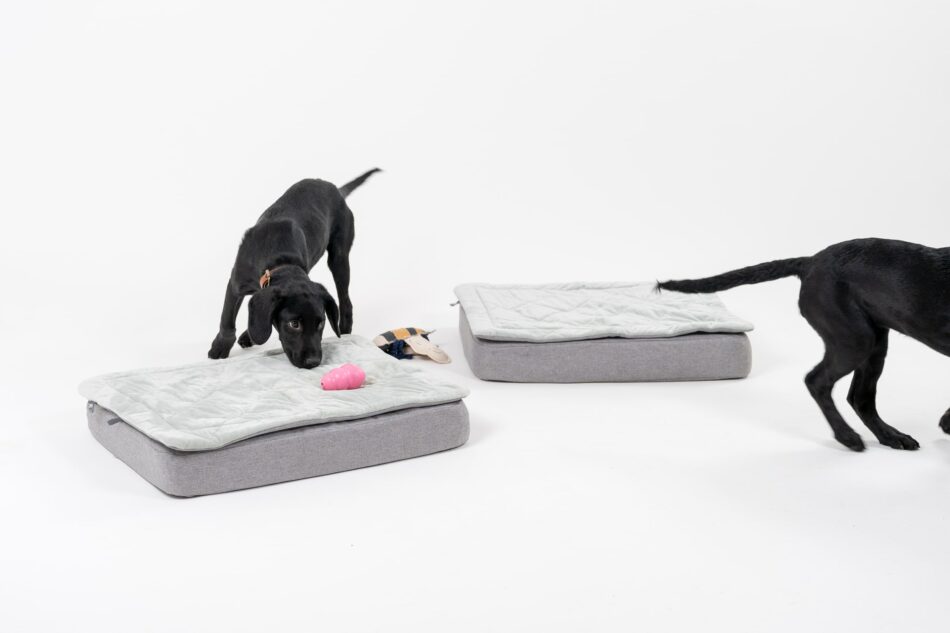
This entry was posted in Dogs
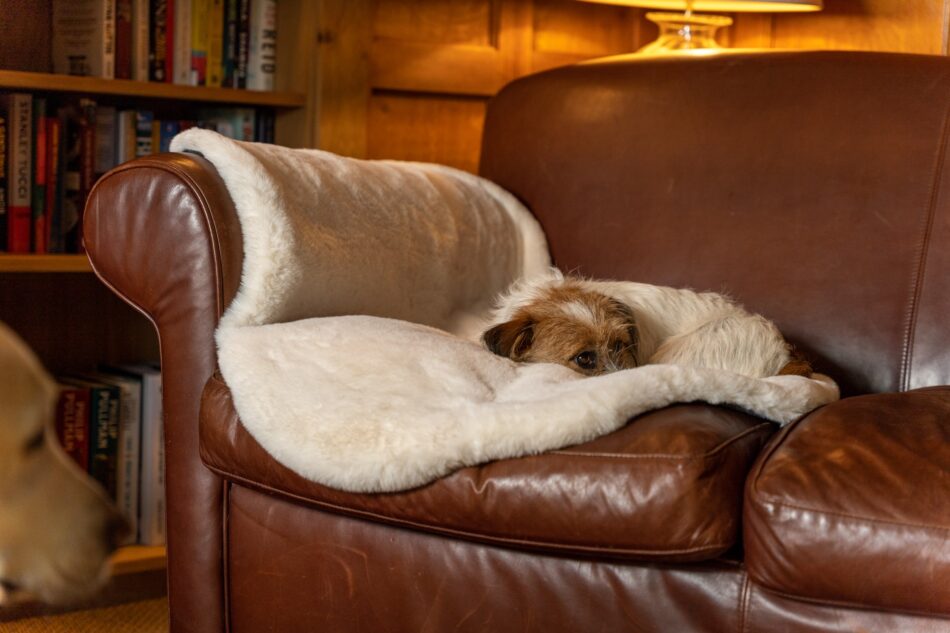
Most dogs dig the winter! Jumping in piles of fluffy snow and running through forests with winter white paws is most dogs’ dream! But depending on dog breed, some find the winter season more magical than others.
While enjoying the beauty of the snowy colder months with your dog can be loads of fun, without proper care and preparation, extreme weather can also be quite treacherous for dogs and humans alike! That’s why we created this list of 5 helpful tips to keep your dog safe this winter.
Shorter walks
Walking in a winter wonderland is a dreamy thought especially if it’s with your bestest furry four-legged friend. But as idyllic as that holiday scene may be, the truth is, some parts of the country get entirely too cold for dogs to handle being outside for extended periods of time.
So what does that mean for your dog’s treasured walks each day? Just because it’s cold out doesn’t mean their walks have to stop! Instead, increase your usual 1-2 long walks per day to 3-5 short walks so the amount of time spent outside is the same, but in shorter periods of time.
This way, your dog can still enjoy the fresh air and release some energy but without getting frozen paws in the process! Don’t forget to thoroughly dry those foot pads before coming back inside – because no dog likes cold, wet feet.
Appropriate attire
While you are digging through your closet to pull out your wooly winter sweaters, feel free to fetch a dog coat (or two!) for your furry friend as well! Even though dogs are covered in coats of hair and fur, they can still get too cold in the winter months if not protected.
Your dog’s ability to handle colder temperatures is entirely dependent upon their age, breed, and size. Thicker coat breeds, such as Huskies and Akitas, may be able to handle lower temperatures, but even these “winter dogs” need to have protective gear when being outside in winter!
Make sure you have a warm, waterproof dog jacket or sweater that is not too tightly fitting for your dog to wear. If your part of the country has snow on the ground most of winter, think about getting some dog booties as well for your pup. The salt and ice can get stuck in their paws on even short intermittent walks causing irritation later if not cleaned out.
And for those last potty breaks before bed, attach a flashlight to your dog’s harness or collar so both you and your dog can avoid any icy patches!
Winter dog grooming
Making sure your dog’s fur is well-groomed is not just a hot weather activity. In fact, keeping up with your dog’s coat in the winter is almost just as important as any other time of the year!
Here’s why – a healthy coat on a dog acts like a temperature regulator. It can keep them cool in the summer and warm in the winter. So maintaining a regular brushing schedule of your dog’s coat is essential during winter to ensure their bodies continue to do what they naturally do which is keep them comfortable! And be sure to avoid any complete hair shavings during this time of year.
What about the paws? Don’t forget to pay closer attention to your dog’s nails this winter and keep them trimmed. Walking on snow lined pathways may seem soft and nice, but this means that your dog’s paws aren’t getting the natural manicure they are used to when walking on hard concrete.
Indoor winter fun
Frost-covered windows and snowy white drifts outside create a need for warm places to cuddle inside! And who better to enjoy a cozy snuggle with than your dog?
When weather conditions become too extreme to be outside longer than a quick puppy pee, that means it’s time to create a cozy cuddleland indoors! In order to avoid cabin fever, have lots of dog toys on hand to keep your pup physically and mentally active. This is a great time to play new games of “hide and fetch” with your dog so they can get out some energy while also engaging more with you!
And after they have a good round of tug and play, be sure your dog has a cozy spot to snuggle into for a nap or the night. Even if your house is heated, the floorboards can still be too cool for a dog to lay on, so get a bed that is elevated to allow for more warm air to flow around them. The Topology Dog Bed designed by Omlet is a great option as the toppers and mattress covers are machine washable, making it super easy to clean!
Is your dog more of a “need a retreat” kind of dog? Then get them a comfortable dog den of their own to get cozy in like the Fido Nook Dog Crate designed by Omlet. Add a super soft sheepskin blanket to their sleeping quarters and you will have your dog dreaming of sugar plum fairies in no time!
Cold weather pet care
Dogs are no different from humans when it comes to health and the dangers of extreme cold weather conditions. Have you ever noticed that small aches and pains in your joints tend to feel worse in the winter? That’s because colder temperatures increase the pressure inside your joints, causing pain receptors to be more sensitive and resulting in a greater sense of discomfort.
Well the same is true for dog’s who have any medical conditions with joint pain or arthritis. The colder winter weather decreases their circulation and increases the stiffness in their already strained muscles and joints.
So what can you do to make your dog more comfortable this winter? Several factors can account for your dog’s medical condition so it’s always best to consult with your veterinarian about your dog’s specific needs. But some best practices include keeping weight gain at a minimum, finding lots of ways to keep them warm, and being sure they have a comfortable dog bed to rest on.
Dogs who are prone to joint pain should also continue to move despite the thought that rest will make it better. Just be sure to stick to walks on cleared paths to avoid the slippery ice and snow that can make walking difficult for both you and your dog!
Winter is here! Experiencing these colder months with your dog can make this season more memorable and enjoyable for everyone as long safety measures are in place! So gather the dog blankets, heat up the hot chocolate and watch the snow as it gently falls out your window. With these 5 tips and lots of your love, your dog will be kept safe and warm all winter long!
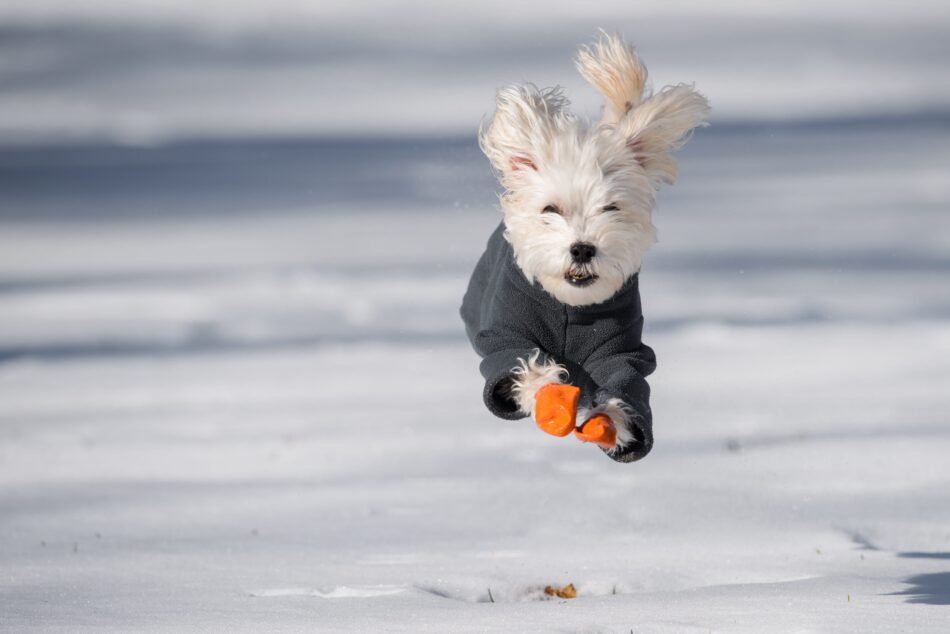
This entry was posted in Dogs
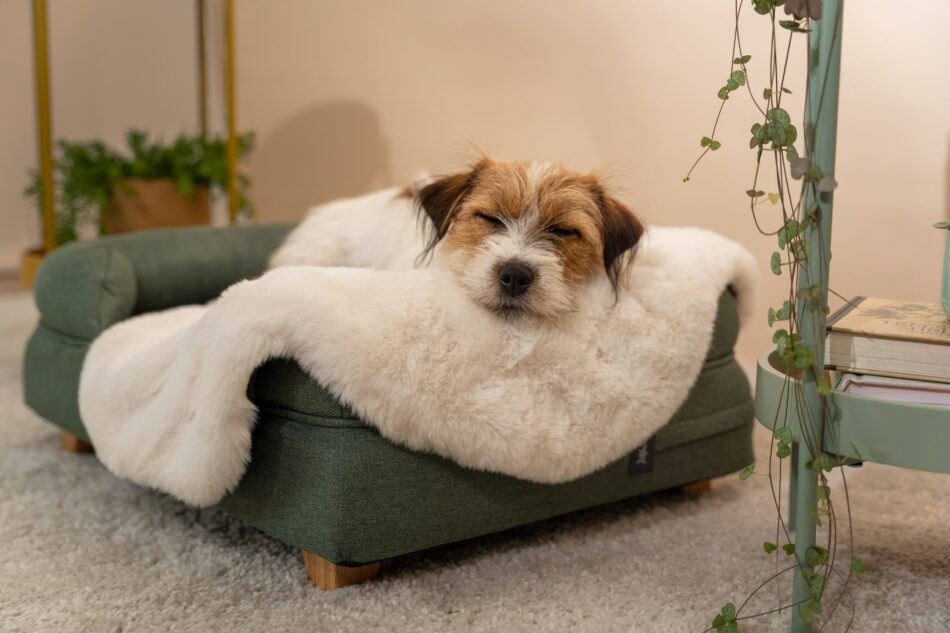
The leaves are falling and temperatures are dropping. Fall has faded into winter and the crisp air hints at colder weather to come. As you move into winter with a cozy jacket, help your pooch conquer the cold and welcome in the new season by your side. Follow these tips for transitioning your dog into winter and watch them wag their tail goodbye to crunchy leaves and hello to snow-filled strolls.
How cold is too cold?
Most dogs can tolerate cold temperatures pretty well – they do have a built-in fur coat, after all. But how do you know when winter cold is too much for Fido? The best way to temperature check your dog is by looking out for these signs:
- Sitting in a hunched position with their tail tucked in.
- Whining incessantly – this is usually dog speak for “I’m cold – let’s go get warm”.
- Reluctant to go on a walk when they usually love being outside.
These breeds were made for winter
All dogs need some extra care and warmth during the winter months but certain breeds are more susceptible to becoming too cold. Those most likely to need the help of a winter coat are the smaller, short-haired breeds like beagles, pugs, and chihuahuas. Hardier dog breeds such as Siberian huskies and malamutes, on the other hand, fare much better in cooler climates.
Don’t be fooled by their size – there are a few larger dog breeds that struggle in the winter, too. Great Danes, Salukis and German shorthaired pointers are a few examples that are more averse to chilly temperatures due to their shorter coats or minimal body fat.
You’ll want to pay close attention to your dog’s body language on cooler days. Temperatures of 45℉ or below can become risky for long walks or extended outdoor play for dogs susceptible to getting too cold, including older dogs as well.
Winter entertainment essentials
Cold-weather walks around the block may suffice in some parts of the country for dogs this winter, but when the temperatures start to plummet too low, it’s time to move the exercise indoors.
Keeping your dog stimulated indoors is important all year round but especially when conditions mean daily walkies might be off-limits. Here are a few ways to keep your dog active indoors when it’s too cold to play outside:
- Toys, toys, and toys. Whether plush or hard, squeaky or silent, dog toys are an excellent way to keep your dog’s playtime going when indoors. Plus, a game of tug of war or indoor fetch are great bonding activities for you and your pet.
- Hide and see the treats. One of the best ways to get your dog moving is to have them hunt for hidden treats throughout the house. This game doubles as brain training too, so your pup will be able to get both a physical and mental workout in.
- Have a playdate. When it’s too cold to meet up at your favorite dog park, consider having a dog friend over instead to burn off some energy.
- Training and tricks. Take advantage of the extra time with your furry friend by teaching them a new trick. Keep sessions short and be sure to use plenty of treats and praise to get Fido motivated.
Creating your dog’s winter wonderland
To make sure your dog stays snug this season, create a winter wonderland inside by cozying up your quarters. Winterproofing your home for your dog has never been so easy with Omlet’s range of ingeniously designed products to take you through the year.
Nothing’s better than coming home to a warm bed after being outside on a winter’s day. And with Omlet’s Topology Dog Bed not only will you provide your pup with an unparalleled sleep experience on a supportive memory foam mattress, but you can customize their topper from a variety of options that keep them warm and cozy all winter long. Simply zip on a new topper when it’s time to get comfy and zip it off to clean those muddy paw prints with a quick spin in the machine.
Choose from the Sheepskin topper for the ultimate snuggly soft sleep, or for post-snowy walkies, the Microfiber topper is quick drying to get them feeling warm again in no time.
To take their bed to another level of comfort, layer up with the Omlet Luxury Faux Sheepskin Dog Blanket. Or place the plush throw on your bed or couch so you can share a snuggle together. Plus, with three sizes to choose from, you can choose a blanket big enough to wrap around any dog.
Should your dog’s diet change in winter?
While humans may sometimes gain an extra layer of warmth during the holiday seasons, be careful your dog doesn’t follow suit. Just like us, dogs may try and consume more calories during winter to try and create an extra layer of warmth. But, overconsumption of food can lead to health complications in the long run if not watched carefully.
If your dog is active the rest of the year but they start to slow down during winter, you’ll want to maintain a steady calorie intake to not add too much weight. Speak to your veterinarian about switching their diet away from foods high in carbohydrates and more protein and fiber-rich foods to keep them fuller longer.
An extra helping of omega-3 will also be beneficial for your pup this season. This will help with keeping their skin and coat in top condition, free from flaking and itching. Your veterinarian will be able to tell you what they think is best for your pet, but dog-friendly omega-3 supplements are readily available online or in your local pet store.
Omlet and your dog’s winter
Winter can be one of the best seasons, especially with your dog by your side. While you might be spending more time on the couch and less time out on adventures, with products like the Topology Dog Bed, Luxury Faux Sheepskin Dog Blanket and dog toys from Omlet, transitioning into this wonderful time of year has never been easier.
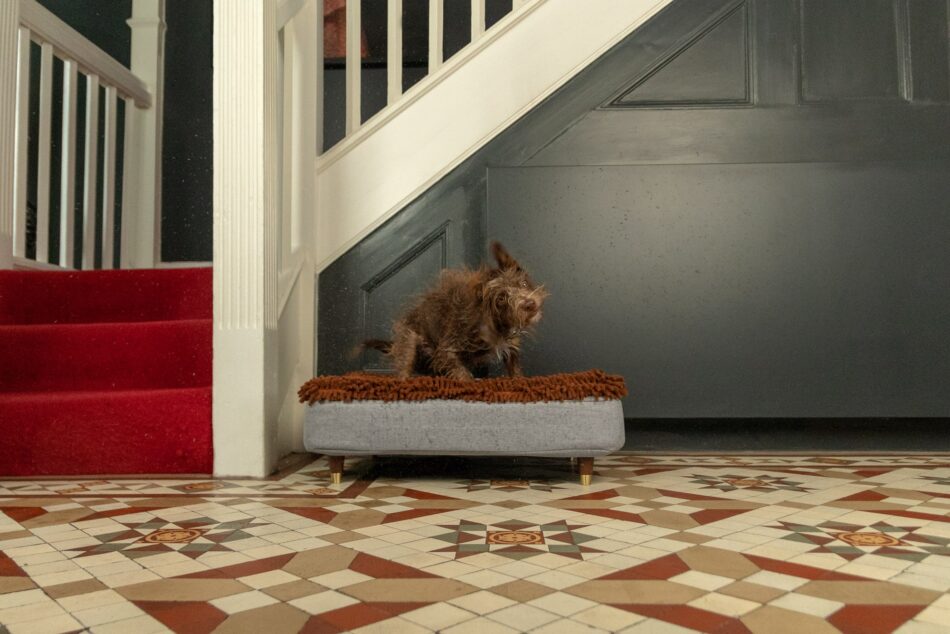
This entry was posted in Dogs
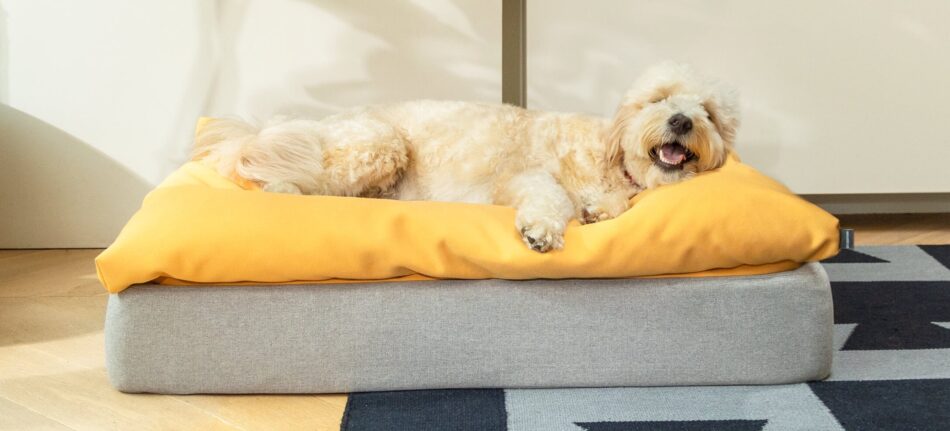
If there’s one thing that dogs have their paws on the pulse of it’s sleep! Whether on their bed, on your bed, on the couch, or on the floor, dog owners everywhere are envious of how much their dog can snooze.
But what if your dog’s sleep is not quality sleep? What if they are catching most of their snoozes during the day and are restless at night? We know that sleep is super important to our dogs so we have the tips and products to help you get your dog sleeping better through the night!
Why quality sleep is important for your dog
Just like us, dogs need sleep in order to stay healthy in mind and body. A good rest not only provides their body with the recharge needed to maintain a strong immune system, but quality shuteye also gives their brains a chance to process all the day’s events and improve their memory. This is why a comfortable and supportive dog bed is so important.
While your dog lies in a dreamland sleep, the cells in their brains and body are regenerating to allow for stronger and more healthy joints and muscles. A restful sleep also increases your dog’s natural production of antibodies which, in turn, allows them to stay healthy.
The importance of a good dog bed
How often do you replace your own mattress? If you’re like most Americans, the answer is likely every 7-10 years. But what about your dog’s bed? A quick search will show that the average lifespan of a dog bed is between 1 and 12 months. At Omlet, we decided that statistic was crazy and that something had to be done about it.
Quality sleep isn’t just important for humans, it’s important for our dogs as well. So the bed they spend so much time getting that restful sleep on is important. We know the reason standard dog beds do not last long is because they are not made to last. Designed with stuffing that is not supportive on joints and covers that are not machine washable, standard dog beds degrade (and smell!) more quickly as they are not built to handle the natural behaviors of dogs.
So we asked ourselves, how do you feel after a good night’s sleep? Refreshed? Energized? Happier? That’s because you slept on a high-performance, quality mattress. We took that knowledge and transferred it to our dog bed designs because your dog deserves all those benefits as well! At Omlet, we design our dog beds to stand the test of time when it comes to your dog’s comfort, your maintenance and the sustainability of their properties.
The Topology Dog Bed designed by Omlet is the last dog bed you’ll ever need to buy. Curated with a supportive memory foam mattress to cushion your dog’s body and a removable topper that is completely machine washable, your dog’s first sleep on this luxurious dog bed will feel just as good as their 100th sleep.
How many hours of sleep does my dog need at night?
Out of the 12 to 18 hours a day that an adult dog logs in sleep, approximately 8-9 of those hours should be spent in nighttime slumber. However, age and breed can have a big impact on these sleepy hours.
Puppies: Anyone who has ever owned a puppy knows that sleep comes quickly and often for these pint-sized pooches. With an average of 20 hours a day spent in snoozy snuggles, most puppies should be getting an average of 6-10 of those hours at night. Of course, potty breaks can account for a more staggered sleep schedule, but by 8-12 months of age, most puppies should be getting about 30%-40% of their total sleep at night.
Seniors: As we get older our sleep becomes more important – and more frequent. The same is true for older dogs. Depending on breed, most dogs will start logging more naps and earlier bedtimes around 7-8 years of age. Senior dogs require more sleep than their younger counterparts because the changes in their bodies require more downtime to recharge. Rest assured that this change in sleep pattern is completely normal and natural.
Breeds: Certain dog breeds require more shuteye than others and the results are often surprising! Tiny breeds like Chihuahuas and Dachshunds typically only need 14-16 hours a day in order to be at their best. Whereas larger breeds, such as Great Danes and Mastiffs need closer to 18 hours a day for a fully rested recharge. When it comes to sleep, size really does matter!
Three reasons your dog isn’t sleeping at night
While there are many factors that can impact a dog’s nighttime sleep, there are three common reasons why your dog may have restless night wiggles. Here are some ways you can help them sleep better:
- High energy levels – An exercised dog is a tired dog. One of the biggest reasons your pup may not be able to settle into slumber at night is because they still have energy to get out. While keeping your dog physically and mentally stimulated all day long is important, those end-of-day, nighttime walks or play sessions are key to their nighttime sleep. So before you both snuggle in for the night, enjoy one last walk together or a round of play with dog toys to tire everyone out!
- Separation anxiety – There is a reason the saying “man’s best friend” rings so true for dog owners – our pups are family. And your dog feels the same about you! Separation anxiety can occur in any dog and leaves them feeling stressed or fearful when left alone for too long. But there are many ways you can help ease your dog’s worries and get them sleeping better through the day and night. Try keeping a soft blanket on their bed or favorite nap spot that will help provide them calm and comfort when you are out. You can also leave one of your unwashed shirts with them, too – a familiar smell will help to quickly calm the anxiety.
- Too uncomfortable – Have you ever been able to sleep well on a bumpy mattress or with a lumpy pillow? Your dog doesn’t like uncomfortable sleeping situations either, and that could be the reason they are up all night. Thankfully, Omlet has designed several sleeping solutions that are not only undeniable in dog comfort, but they can be perfectly placed anywhere in your home.
Your dog may need a more den-like space to snooze and snuggle, so the Fido Nook Luxury Dog Crate and Bed designed by Omlet is the ideal answer to snoozy prayers! Or maybe their dog bed needs an upgrade just like our mattresses often do. In that case, the Topology Dog Bed also from Omlet allows you to not only customize your dog’s specific sleeping style, but the style as well.
Can my dog sleep in a bed with me?
Sharing your bed with your dog can be a truly enjoyable experience. However, while many dog owners agree that co-sleeping with your furry friend is harmless, there can be some drawbacks to shared snuggles.
If your dog is prone to separation anxiety or regular stress, then allowing them to snooze alongside you at night may provide them with the sense of security they need to sleep restfully. Plus, snuggling with your pup is a terrific bonding experience. Allowing your dog to co-sleep with you can also strengthen both your relationship and happiness. And we all know that sleepy dogs are happy dogs!
But some of the drawbacks of sharing your bed with your dog could potentially be impactful to your health. If you have any dog hair or dander allergies, then co-sleeping at night with your dog is not the best idea. Spending the night covered in dog hair will lead to nightmares rather than good sleep. So in this case, make sure fido has a comfortable dog bed that they will love just as if it were yours!
Creating a bedtime routine
Dogs are creatures of habit, so establishing a routine around bedtime will not only appease their innate desires for consistency, but it will also ensure a better night’s sleep. We have dug up several tips that will help make nighttime tuck-in a breeze for you and your dog. Use just a few or incorporate them all to maintain a regular and restful night’s sleep!
- Because exercise is key to a dog’s sleep demeanor, start by setting a time right before bed to have one last run in the yard. Whether a long walk around the block or just a quick game of fetch, your dog’s breed and exercise needs will help you determine what activity is best to help tire them out.
- Keep mealtime consistent! Feeding your dog at the same time every night before bed triggers an association signal in their brains. When dinner in the dog bowl is served, they know that bedtime is right around the corner. And this will make sleeping through the night much easier!
- Bathroom before bedtime is essential. Just before you are ready to snuggle up under the covers, be sure your dog has one last potty break to empty their bladder. Both you and your dog will be thankful!
- If you crate train your dog for a more secure slumber, be sure to keep the crate somewhere quiet and calm for the night. Whether that’s your bedroom or another cozy spot, your dog will more easily fall asleep and stay asleep in their dog crate when in peaceful surroundings.
- Final tuck-in for bed! Make sure your dog has a comfortable and supportive bed to spend the night. The Topology Dog Bed designed by Omlet not only gives your dog the snuggled coziness they desire, but it will keep them comfy all night long. Add a soft dog blanket to their bed and bedtime is sure to be a success!
How Omlet can help upgrade your dog’s sleep
Upgrading the quality of your dog’s sleep is often just as easy as upgrading their routines and sleep spots. That’s why we designed products like the Topology dog bed,the Fido Nook dog crate and a variety of super soft and snuggly dog blankets. At Omlet, we believe the products your dog sleeps on are just as important as the bed you choose for yourself.
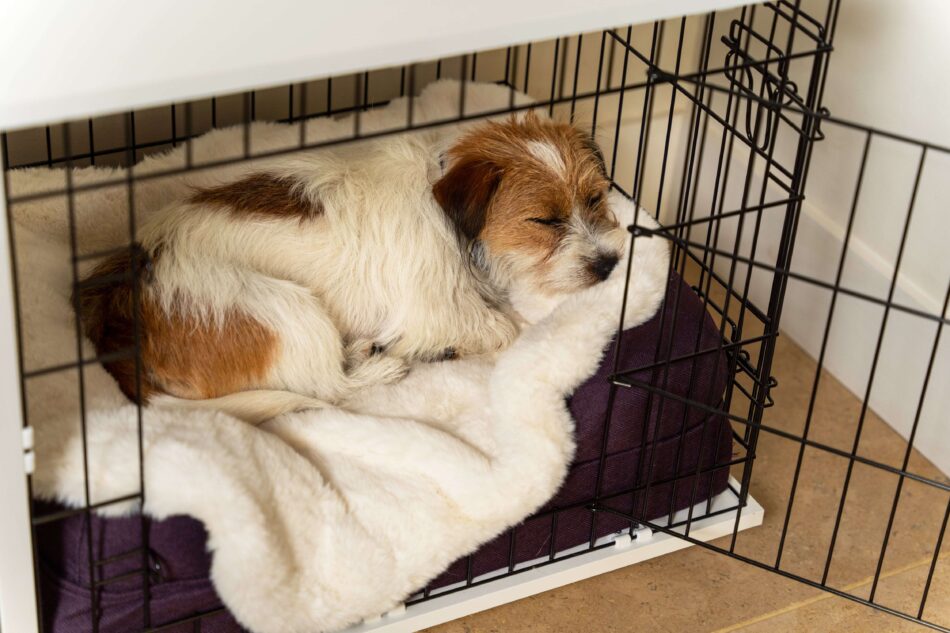
This entry was posted in Dogs
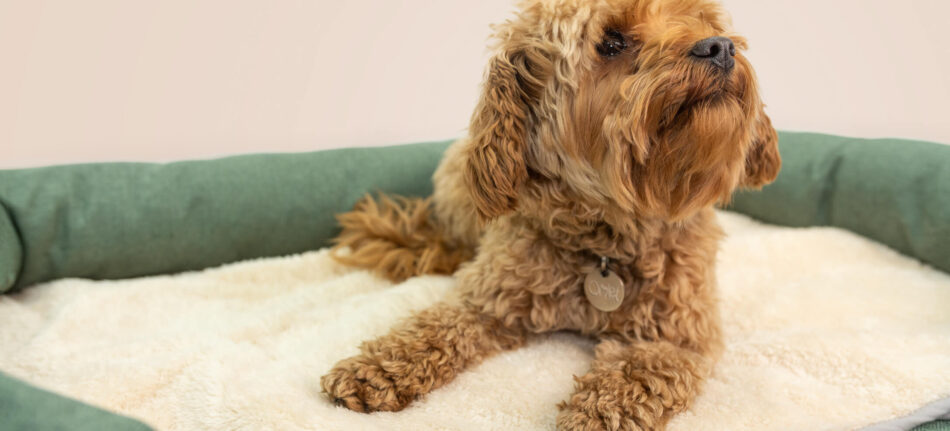
An anxiety dog bed can help to soothe your pup, and give them a calm place to rest and recuperate. Anxiety is an issue that affects many dogs. Some breeds are prone to nervousness, and some individual dogs may have had a tough puppyhood that results in anxiety as an adult. Others may have issues such as joint pain that require extra comfort and a cozy corner. Our guide to anxiety dog beds could help you decide whether your dog would benefit from one, and the best choice for your dog to slumber.
Symptoms of anxiety in dogs
Before investing in a dog bed to help ease anxiety, you may need to identify if your pet has anxiety. Understanding your dog’s body language will help you identify a problem. The symptoms of anxiety in a dog or puppy may include:
- Hiding
- ‘Burrowing’ under blankets, cushions or on a bed (the dog bed or the owner’s bed!)
- ‘Cringing’ (with the tail between the legs)
Some dogs will express anxiety through the following:
- Whining and whimpering
- Panting when there has been no energetic activity
- Shivering
- Jumping
- Occasionally an anxious dog may even express itself through nipping and snapping.
Whilst a comfy dog bed can help to ease symptoms, if you’re concerned that your dog is showing any of these signs, you may wish to have them checked by a vet.
What can calm an anxious dog?
Treating dog anxiety is not a straightforward issue, neither in humans nor dogs. While humans can talk to someone about the issue and receive good advice, the options for a dog are more limited. Positive training can go a long way towards reducing dog anxiety and boosting confidence. Whilst a calm environment can have a very positive impact, too. A soothing dog bed can make a big difference here, giving your pet a safe place to unwind and relieve anxieties.
Dog anxiety often stems from puppyhood stress. With rescue dogs, the events in the early months of your pet’s life are often unknown. Dog anxiety is usually linked to separation, though. Out and out abuse manifests as fear and lack of confidence in dogs, but anxiety is something slightly different. A high quality calming anxiety dog bed can help pets with a mild form of separation anxiety. That is, if your dog frets when left alone, or is particularly ‘clingy’ with one member of the family.
Dog anxiety can also be brought on by discomfort. Many dogs suffer from joint pains, notably in the hips as they grow older. Lying on a blanket or a thin dog bed that’s too small will not give these dogs the comfort they need for a good night’s sleep. Which leads to a vicious circle of anxiety-inducing poor sleep and stress. An anxiety dog bed is designed to give your pet the support they and their joints need for a peaceful rest. Which could in turn help to lower their anxiety levels. Choosing the right dog bed for your pet involves a number of factors from the size, to how easy the dog bed is to wash, to material, and color.
How an anxiety dog bed can help
A comfortable anxiety dog bed provides your worried pup with that all-important sense of security. Such dog beds may feature orthopedic padding, dog blankets or quilts for really snuggling down, extra-soft cushions and raised sides for resting a lazy head on.
Even the best anxiety dog beds alone will not ‘cure’ a pup’s anxiety. They need to be part of a general dog-friendly environment. Combined with a consistent behavioral dog training program, a healthy diet, supplements, and – if absolutely necessary – medication. Anxiety dog beds, then, are where dog owners should start when addressing anxiety issues, but they are only part of the wider solution.
4 characteristics of an anxiety dog bed
For those searching for a soothing dog bed to help ease their pet’s anxiety, these are a few key features you should look out for:
- A raised outer border – the enclosed shape will help your pup feel safe and secure.
- Machine washable – having a dog bed that can be cleaned easily means your pet will always have a clean, comfy place to relax.
- Super soft – just like humans, dogs enjoy soft fabrics and this can help soothe them. You can always add a luxury sheepskin dog blanket for extra comfort.
- Memory foam – having an ultra comfortable mattress on their anxiety easing bed can help your pet feel at ease.
Choosing the right anxiety dog bed
Every dog is different and so requires a slightly different dog bed to soothe anxieties. Here are our top things to consider when choosing an anxiety soothing bed for your dog:
- Size – Every breed of dog has a different size, from very small dogs such as chihuahuas, to very big dogs like Bernese Mountain Dogs. Choosing a small, medium, or large dog bed that will fit your dog comfortably is especially important for those pets with anxiety.
- Material – Make sure the bed has a soft material that your pup will love lying down on.
- Color – Whilst the vital part of a dog bed for anxiety is that it fits your pet’s needs, you may also wish for it to suit your interior. Our range of beds for pets come in a wide range of colors perfect for every home.
Finding the perfect spot for your anxious dog’s bed
The central part of a calm environment for dogs is the bed. The location of the pet bed is important. It needs to be somewhere relatively quiet, where the dog can feel safe and in control. The design of a bed for dogs is equally important, and a comfortable dog mattress is the beginning, rather than the end of the story.
So, what type of bed does a dog prefer? For many dogs, a bed is simply the place where they lie down and sleep. It doesn’t even have to be the same spot each night. Some dogs like to spend one night on their allocated bed, the next night in a cool spot on the kitchen floor, and the next night your pet may want to share a bed with you. But with anxious dogs, consistency is important, and the right anxiety dog bed in the right place is the key.
An anti-anxiety dog bed can actively reduce stress and worry. When combined with anti-stress training, the anxiety dog bed can go a long way towards eliminating the issue. Calming supplements can also help, and in extreme cases, a vet will recommend anti-stress medication, too.
Do anxiety beds for dogs work?
An anti-anxiety dog bed is all about giving dogs and puppies a sense of security, reinforced by sheer comfort. The key is in the design of anxiety dog beds, and there are many models to choose from. The best options include dog beds that go the extra mile to enhance your dog’s comfort, including features such as a removable cover, orthopedic foam, memory foam, and a washable cover (machine washable, ideally). Dogs love their comfort, and a consistently good night’s sleep, after all, is one of the best ways to tackle and reduce their anxiety.
Comfy, soothing dog beds from Omlet
We have two types of dog bed that could be used to calm anxious pups:
- Topology Luxury Dog Beds – Designed to be easy to clean, and super comfy with a memory foam mattress, this anxiety dog bed is a cozy place for your pup. Available in three different sizes, so you can find the perfect fit for the dog breed you own.
- Memory Foam Bolster Dog Bed – The Bolster dog bed for anxiety is set apart by its high sides that are the ideal place for your pup to snuggle or rest its head.
A top class calming dog bed won’t cure dog or pup anxiety on its own. But a good night’s sleep is half the battle. Providing the dog with a comfortable start and end to each day, making the rest of the anti-anxiety routine a little bit easier.
Introducing Omlet petcare
Make your dog as comfy and happy as possible with our range of dog products. With cozy dog blankets, fun dog toys, and yummy treats for pups, they’ll be excited when their delivery from Omlet arrives!
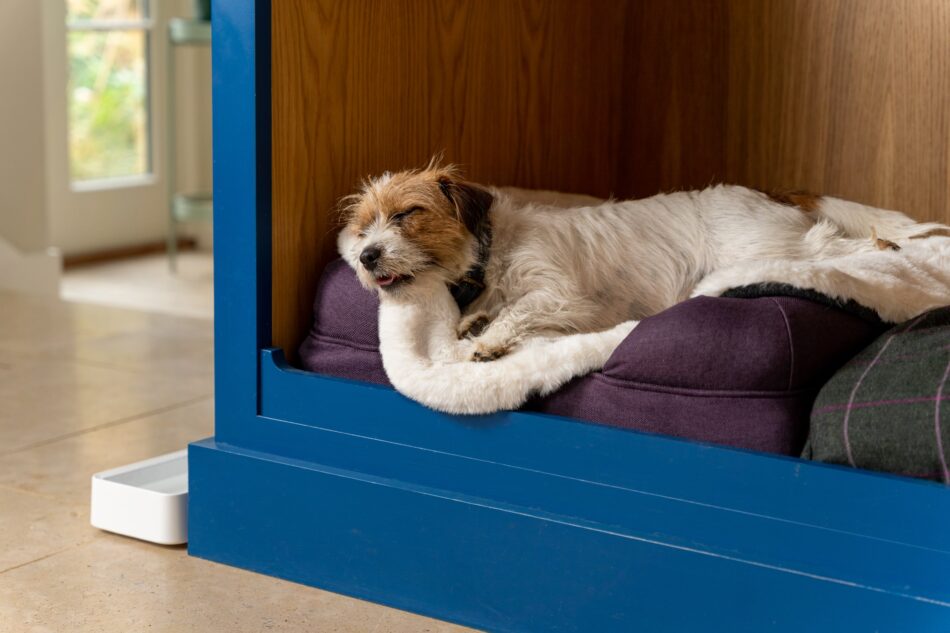
This entry was posted in Dogs
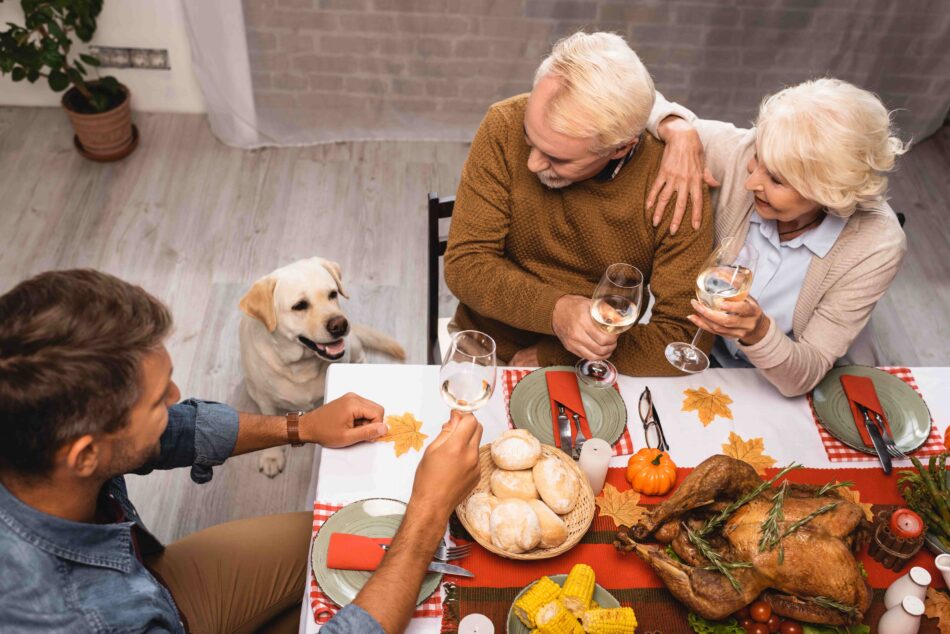
The Thanksgiving holiday is a festive time to celebrate everything we are thankful for, and that includes your dog! With wagging tails to welcome you home and sweet snuggles to keep you warm, we can’t help but give our furry friends great thanks this holiday season!
But how can you ensure your dog enjoys Thanksgiving, too? Is it ok for your furry friend to dine on the traditional family feast? Fetch yourself a seat at the table as we outline everything you need to know to make sure your dog stays safe and has fun this Thanksgiving holiday!
Safe Thanksgiving foods for your dog
While feeding your dog from the table can be tempting, serve up safe Thanksgiving foods in their normal dog bowl or as you would a treat. And to be sure your dog doesn’t consume anything harmful, here is a list of some safe foods you can let your pup indulge in small bites:
- Turkey – That’s right! Your dog can have a few nibbles of the star of the Thanksgiving show! Turkey is a great source of protein for your dog and they will undoubtedly love a bite (or two!) of the savory meat. Just be sure their portion is fully cooked, unseasoned, and doesn’t include any skin or bones, which aren’t safe for your dog to devour.
- Sweet Potatoes – Rich in beta carotene, fiber, and vitamins, sweet potatoes are a super treat for your dog at Thanksgiving! Some dogs like to eat them baked, other dogs like to eat them broiled, but no dog likes to eat them with seasonings! Spices like garlic and onion will make them sick, so stick to the plain potato variety when serving your dog at dinner!
- Pumpkin – No Thanksgiving meal is complete without pumpkin and, thankfully, your dog can safely indulge in this traditional treat, too! Your dog’s digestive system and skin will benefit greatly from the nutrients in fresh and pureed pumpkin. So when you cut yourself a slice of pumpkin pie, drop a spoonful of pumpkin puree in your dog’s bowl to dine on dessert together!
Not safe Thanksgiving foods for your dog
As any dog owner understands, the nose knows! And especially at Thanksgiving, a dog’s nose will sniff out almost any food or flavor! So in order to make sure your dog stays safe this holiday season, here are a few foods that you want to make sure you avoid letting your furry friend feast on.
- Raisins – These tiny little morsels may seem harmless, however, if ingested, they can have a very big impact on your dog – and not in a good way! Raisins, and their parent fruit grapes, are extremely toxic to dogs, causing intense vomiting and diarrhea if eaten. So when preparing the holiday menu, substitute the raisins and grapes with a fruit that is more dog friendly, like apples, bananas, or blueberries!
- Casseroles – If you have ever celebrated Thanksgiving you know that a staple on the dinner table is casseroles. And while some of the main ingredients in casseroles like potatoes, celery, and carrots are ok for your dog to eat, it’s all the other ingredients that are the real danger. Spices, such as onion, pepper, garlic, and nutmeg can cause irritation to your dog’s digestive system and make them sick. So since most casseroles include at least one spice, best to avoid sharing this dish with your dog altogether!
- Bones – Give a dog a bone, right? Wrong when it comes to turkey bones! It may seem only natural to give your dog a bone from the carved turkey, but doing so could be very dangerous to their health. Unlike dog chew designed bones that are safe for your dog to gnaw on, turkey bones can be small and splinter, causing your dog to potentially choke.
In the unlikely event that your dog does happen to eat any unsafe foods this Thanksgiving, be sure to contact your veterinarian immediately to seek help.
Fido fun on Thanksgiving
One of the best parts of the Thanksgiving holiday is the time off from work to relax and enjoy with friends and family. And no family member is more excited about getting to spend time with you than your dog! The most magical time of the year is meant to make magical new memories and who better to do that with!
So take full advantage of this quality time to do more fun activities with your dog. If your furry friend is used to quick morning or afternoon walks before and after work, use this extra time off to linger longer on those strolls. Or, create new adventures and memories by exploring new trails or parks in your area.
What if it’s too cold where you live to be outside for long periods of time around Thanksgiving? Just take the pawty inside! Stock up on some favorite dog toys so you and your dog can play for hours while staying cozy and warm. Your dog will love a good game of “fetch and seek” and you will love that your dog still gets exercise to tire out!
Dogs and Thanksgiving guests
When the Thanksgiving holiday rolls around, you are bound to welcome friends and family into your home. While most dogs love meeting new people and getting pets and pats from strangers, some pups can get very anxious and stressed with too much commotion.
So how do you make sure your dog is ok with the holiday hustle and bustle in your home? Thankfully, Omlet has the tips and products to make sure your dog stays jolly and joyful this holiday!
Extra Exercise: A tired dog is a happy dog! So before the fun festivities of Thanksgiving begin, make sure your dog gets plenty of exercise to tire out those wiggles. Take them on a longer walk than usual or for an extra long game of fetch outside before guests arrive. You can also play some mental stimulation games inside so they can release some pent-up energy! That way when your company arrives, your dog won’t feel chaotic or stressed!
Designate A Doggie Den: For the dogs who get anxious with people coming in and out of your home, creating a familiar place for them to escape to is essential! Place their bed in a quiet room or corner where they feel comfortable and secure so they can get a nap when needed. The dog beds designed by Omlet are a great snooze option for any dog as they can be customized to fit your dog’s exact needs! And if your dog is crate trained, consider upgrading their safe place to a “home within a home” with one of Omlet’s wide variety of dog crates.
Layers on Layers: If welcoming guests to your home is a regular and stress-free experience for your dog, then this Thanksgiving should be without worry! For the cuddle pups who like to snuggle family and strangers alike on the sofa, make sure you have some layers to protect your furniture and your guests! The Super Soft Dog Blankets designed by Omlet are a great option because they offer a warm, snuggly spot for your dog to land when greeting guests!
Before you roast your turkey or bake your pumpkin pie this Thanksgiving, remember to give thanks for the constant companion in your life! We think dogs can receive love in many different ways and that’s why we created our exclusive line of dog products to give thanks back! Making sure your dog enjoys the magic of the holiday season is just as important as the festivities themselves!
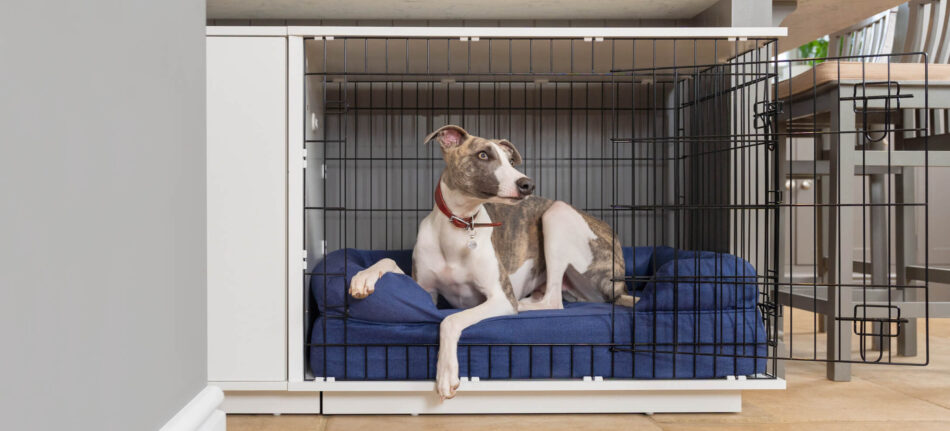
This entry was posted in Dogs
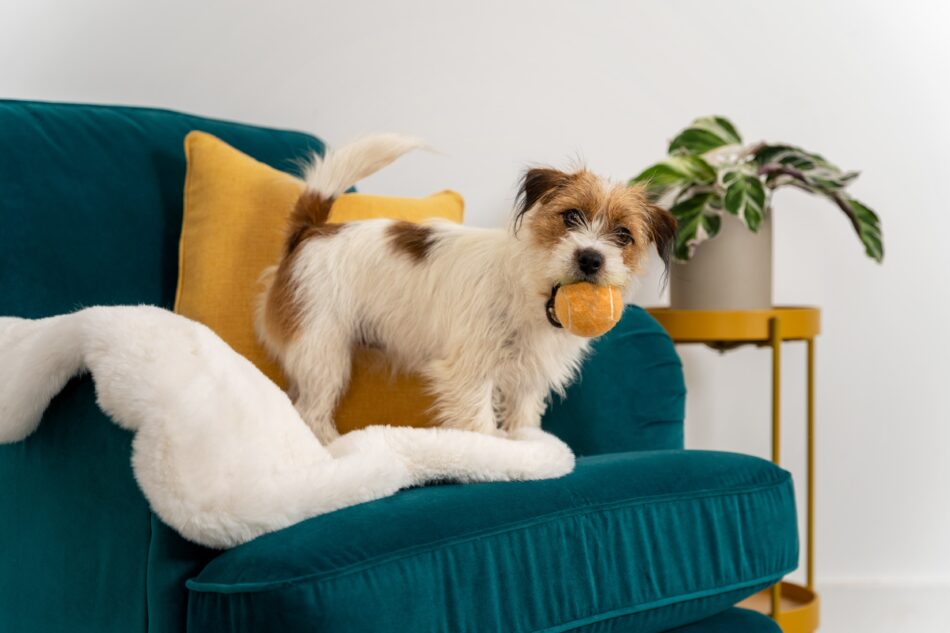
One of the best ways to relax after a long day at work or on a slow weekend morning is cuddled up on the couch under a blanket. And regardless of the temperature outside, blankets make us feel cozy and secure.
But what about dogs? Do they need blankets too? We absolutely believe they do! And it’s for the same reasons we humans love them! So, where should you put your dog’s blanket? We have everything you need to know on blanket placement so your dog can rest better!
Do dogs need blankets?
The short answer is, yes! Every canine should have a comforter to call their own. And while blankets are essential for keeping your dog warm, that’s not the only reason they are beneficial for our four-legged friends.
Blankets also give your dog the security they need to feel safe. Why do small children always carry around their favorite stuffed animal? Because the smell and comfort of the item makes them feel secure! Dogs feel the same way!
Some dogs feel anxious or have separation anxiety, so a blanket can help comfort them to feel better. Puppies love blankets too because they are a good chewing tool to help their sharp puppy teeth! Regardless of age, any dog loves a blanket for the reassurance it gives them!
But wait! There’s one more very important reason why dogs need blankets. Or rather, why your furniture needs a dog blanket! Dog blankets are a great way to protect your couch and bed from the unwanted hair and fur that will inevitably make its way all over.

Best blankets for dogs
So can you give your dog just any blanket to lie on? Sure. But would you want to sleep on an old, torn, scratchy blanket? We didn’t think so!
The qualities we like in a blanket are the same your dog likes, too – soft, comfortable, and warm. But when it comes to dog blankets, you also want to make sure you find one that’s durable and easy to clean after they walk in muddy puddles!
Dogs are innately denning animals, which means they naturally seek out the comfort of a small, cozy space to rest or feel secure. Adding a soft blanket to their bed will provide them extra comfort and relaxation.
So what if there was a perfect dog blanket that was soft, durable and easy to clean designed for all dogs of different sizes and breeds? Introducing the Sheepskin Dog Blanket designed by Omlet! Upgrade your dog’s sleep with this machine washable luxury blanket that is sure to be your pet’s new favorite blankie!
Where to place your dog’s blanket?
So where should you put your dog’s blanket? Dog beds are a great place to start, but there are many more options. Let’s take a look!
On your dog’s bed
Sure, the most obvious place to put your dog’s blanket is on their dog bed. Especially if that is the place they nap and sleep most often. On their bed, dog’s will use a blanket for warmth and cuddling as they nest into their naps! And what dog doesn’t love a good snuggle with their snooze?
On your bed
Are you and your canine co-sleepers? Then you definitely want to invest in a dog blanket! Not only will your dog appreciate the personal sense of comfort in having a blanket of their own, but you will appreciate keeping their fur off your comforter. It’s much easier to wash a dog blanket daily then it is a large bed cover!
On the sofa
If your dog is a lazy lap lounger that likes to lie on the sofa all day, then a dog blanket is an absolute must! Let’s be honest, you love your dog like family, but you don’t want to look like you’re wearing them! Instead of covering your pants in dog hair after sitting on the sofa, get your dog covered in a blanket and let the fur be gone! And if you are trying to train your dog to find a new spot to snooze other than the sofa, get them a bolster dog bed that will look and feel like their own canine couch!
In the car
Traveling with your dog can be lots of fun! But for some dogs, car rides can also cause lots of anxiety. One of the greatest qualities of the Sheepskin Dog Blanket designed by Omlet is that it is lightweight and easy to clean, making it your dog’s ideal travel companion! And having a scent from home, like a well-loved dog blanket, will ease your dog’s stress level in car rides!
Next to food and water, dog blankets are one of the most essential items you can buy your furry friend! Not only do they provide the warmth and comfort they seek, but they can be the sense of security that many pups need. Whether on the bed, on the sofa or on the go, your dog will be happier with a dog blanket!
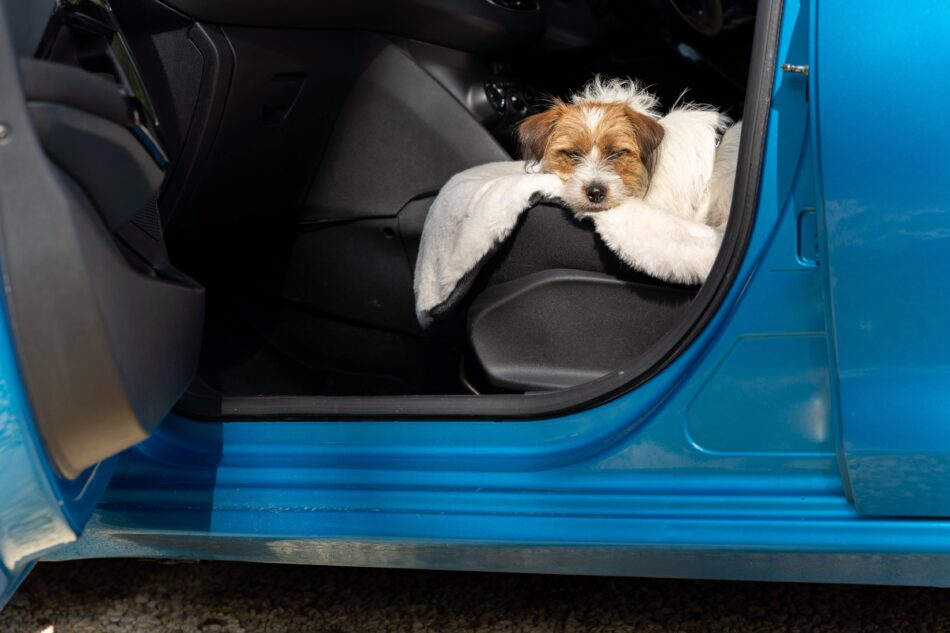
This entry was posted in Dogs
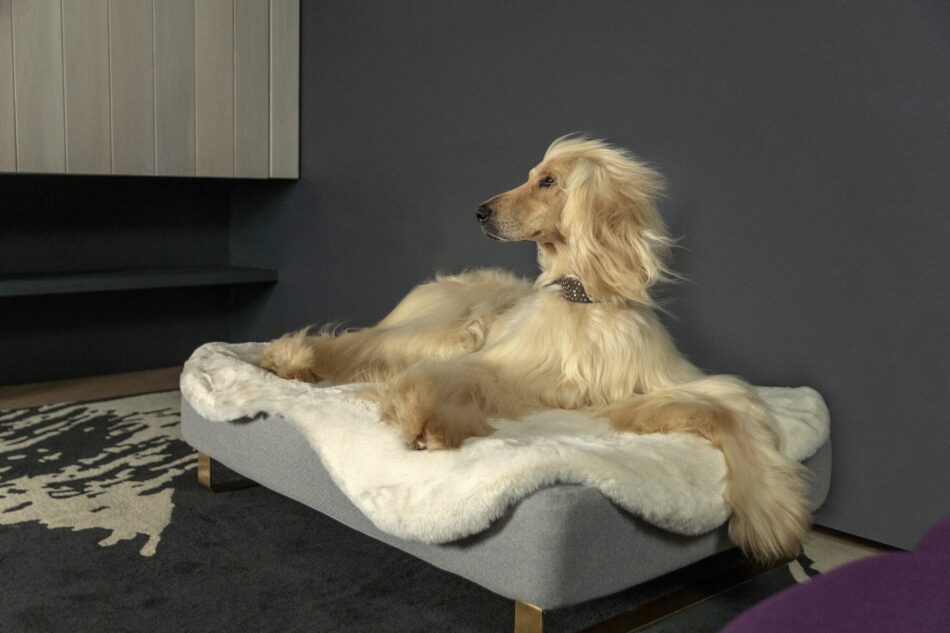
The leaves are falling and the temperatures are dropping and that can mean only one thing – winter is coming! Time to get warm by digging out those winter coats from the closet!
But what about your dog’s coat? Grooming your dog’s coat is not just a spring or summer activity. In fact, keeping up with your dog’s coat in the winter months is likely more important for their health and safety. Let’s take a look at all the winter grooming tips you need to know to keep your furry friend happy!
Why does your dog need grooming in the winter?
A dog’s coat is a two-way protector of temperature – it keeps them cool in the summer months and warm in the winter months. But should a dog’s coat still be groomed in winter? Absolutely! Here are 3 reasons why grooming your dog in the winter is essential for them to maintain a healthy coat and body:
Take out the tangles
If you have ever seen a dog jump in a fluffy white pile of snow, you know all too well how quickly their fur can get wet and matted! Maintaining a daily or weekly brushing schedule will not only ensure your dog’s coat stays clear of any tangles, but it will also help to rid of any unwanted salt or snow that could cause irritation.
Don’t be fooled into thinking more hair in winter will keep your dog warmer! Good winter hygiene for your dog means brushing frequently to de-shed any extra build up of hair. Their coats will naturally do what they do best in keeping them warm!
Protect the paws
If you live in a state that gets lots of snow in the winter, then you know the snowplows are famous for dumping chemicals on the ground to make the ice melt quickly for safer driving. But those chemicals are not pet-friendly! Wiping down your dog’s paws after every snowy romp is very important to make sure they don’t have any residue left behind that they could potentially lick off later!
And don’t forget to trim your pup’s nails more frequently in the winter, too! Winter walks are much softer in the snow and mud so your dog doesn’t get the chance to naturally file their nails on the concrete like they do in hotter months!
Keep skin hydrated
What’s the first thing you do when the temperatures get colder? Turn on the heat inside! But guess what? That artificial heat is what makes our skin drier in the winter and it also does the same thing to our dog’s skin, too! A dog’s coat is only as healthy as the skin below it, and staying hydrated in the winter is key!
If you normally bathe your dog once a month in the hotter months, increase that frequency to twice a month during winter. Just be sure to use comfortable warm water and a moisture rich shampoo or conditioner so you can keep the skin hydrated and the dry patches at bay!
Winter clean dog tips
Snowy dog walks and muddy puddle jumps can make for a dirty dog! So how do you make sure they don’t track winter in from the outside? Here are some tips on keeping your dog clean this winter:
- Keep a dry towel by the front door to wipe down muddy, wet paws
- Get your dog some snow booties to protect their paws and your floors!
- Be sure to wash their bed often! With the Topology Dog Bed designed by Omlet you can buy extra toppers to use throughout winter for the fresh, clean sheet feeling! And, bonus – they are all machine washable!
Does winter dog grooming differ from state to state?
Depending on what part of the country you live in, your winters may not be as harsh as others. But don’t let geography stop you from making sure your dog’s coat is still well-groomed!
Dogs who live in the “endless summer” states, like Florida, Alabama, Mississippi or Louisiana, may only get a few weeks (or even just a few days!) of colder temperatures each winter. Even though they may not be running through plump pillows of snow, your dog’s skin is still affected by the change in temperature, so be sure to keep up a regular schedule of brushing and bathing if you live in the South!
For northern state residents, like those in Vermont, Maine and Minnesota, a well-prepared grooming routine is essential for your dog’s health! If you live in a state where every potty break is like walking in a winter wonderland, consider getting your dog some shoes to help protect their paws even more! Warm dog paws give way to warm dog hearts!
Tips for grooming long hair dogs in winter
Long haired dog owners listen up! Yes, that extra fur on your dog will provide greater warmth, but it’s also a magnet for tangles when wet.
There’s a big misconception that long-haired dogs can be left ungroomed when the temperatures dip because that extra hair will keep them extra warm. Let’s debunk that myth with a few key tips:
- Follow the snow rule! Bathing and brushing your long-haired dog should be kept consistent in the winter, but best to always follow the snow rule: When outside play leaves your dog with lots of snow, a warm bath with shampoo should quickly follow!
- Coats for coats! If your winters see more temperatures below freezing than above, consider getting your long-haired dog a coat of their own. Even though they have all that fur, they could still use some extra protection on walks and outdoor play!
- Add extra layers! Who doesn’t love a good snuggle under a cuddly blanket after coming in from the cold? Cover your dog in cozy with a soft, warm blanket that you can layer on their dog bed for extra warmth!
Tips for grooming short hair dogs in winter
Short-haired dogs tend to feel the cold quicker than their long-haired counterparts, so when winter arrives, make sure you are prepared! Here are a few important tips to make sure your shorter hair dog stays warm and healthy this winter.
- Lots of layers! Your short-haired dog may be your best friend but in winter, sweaters and jackets are theirs. The best way to keep your dog’s coat healthy when it’s cold is to give them extra warmth protection!
- Protect the paws! Most short-haired dogs do not originate from colder climates, so they are not as naturally equipped to deal with winter. To keep their feet warm and dry on walks, invest in some dog booties!
- Indoor play! If winter is a season that stays around for a long time where you live, you need to get creative with how you can still give your short-haired dog playtime without freezing! Stock up on lots of dog toys and turn your living room into a pup playground for winter!
When do dogs lose their winter coats?
Around the same time we start to pack our wooly winter coats back in the closet, our dogs are starting to shed their winter coats too. In fact, you will know spring is around the corner by the amount of furballs you start to see on your floor! The term “spring cleaning” likely came from a dog owner who knows all too well how much fur can be accumulated when winter fades away.
But don’t let this natural shedding process stop the dog grooming routines! Continued daily or weekly brushing, depending on dog breed, is essential during this season change as it will help to keep your dog’s coat healthy.
Keeping up with your dog’s coat in the winter is easy as long as you are prepared. So before you move your thermostat from AC to heat, be sure you have plenty of dog brushes, pup shampoo and dog blankets to get your winter grooming routine ready! Oh, and keeping damp and mud at bay with an easy clean dog bed isn’t a bad idea either!
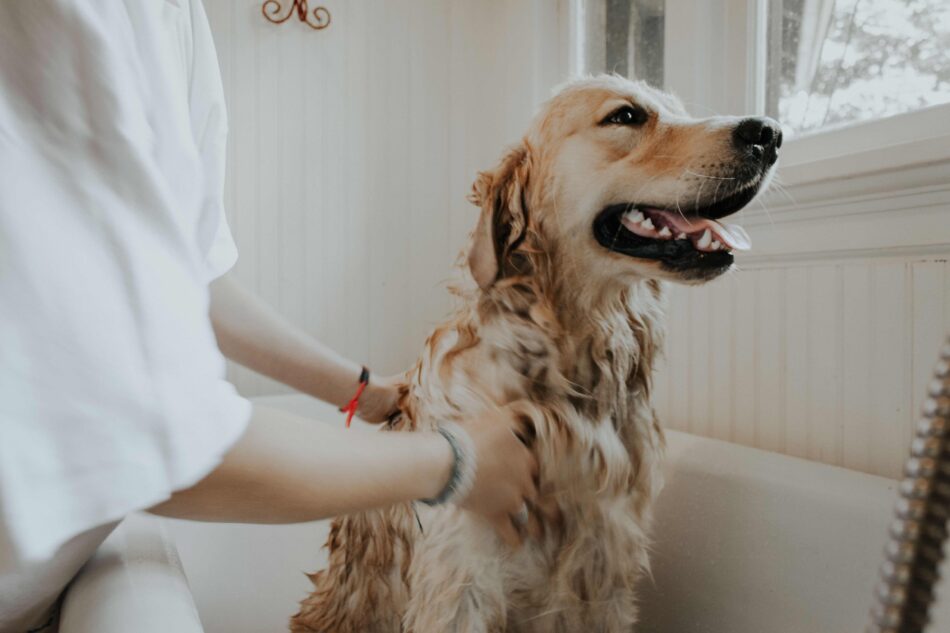
This entry was posted in Dogs




